Abstract
The identification of an unknown gaseous species or the composition of a gaseous mixture can be performed using various experimental techniques such as: mass spectrometry, chromatography, nuclear magnetic resonance (NMR), infrared (IR), X-Rays, or by combining these analytical techniques (in automated analyzers). Unfortunately, these techniques use highly expensive equipment and require the use of qualified personnel. Using gas sensors is a viable and inexpensive alternative. The most commonly used sensors in the field are resistive type chemosensors (chemiresistors), due to their simple detection mechanism and low manufacturing costs. The detection principle of these sensors is based on the catalytic reaction between the sensitive material of the sensor and the target gas. This reaction occurs with the release or consumption of electrons, influencing the overall electrical resistance of the sensor. This review describes various MOX-based chemiresistors, which contain different types of sensitive substrates, such as powders, pellets or films, as well as a clear tendency towards sensor miniaturization and the constant improvement of the fabrication techniques towards greener and more cost-effective synthesis routes over time. The goal of this research was to obtain sensors with high 3S parameters (sensitivity, selectivity, and stability), that can be mass-produced and implemented on a wide scale.
1. Introduction
Breathing air contains three primary gaseous components: nitrogen (N2), oxygen (O2), and argon (Ar). The proportions in which these components are found are N2 = 78.08%, O2 = 20.95%, and Ar = 0.93%. These components are vital for life on this planet. In addition to these molecules, the air also contains other more or less harmful species in concentrations below 0.05% such as carbon dioxide (CO2), neon (Ne), helium (He), methane (CH4), and krypton (Kr). Another important component of the planet’s atmosphere is water (H2O), present in vapor form, in a concentration of 0–3%. Many substances of natural origin may be present in small amounts, locally and/or according to season variables in the form of aerosols (in a sample of unfiltered air), including mineral and organic dust, pollen, spores, or ash particles (in areas with high volcanic activity). Various pollutants coming from industry may be encountered in the atmosphere as aerosols or vapors, such as chlorine, fluorine compounds, mercury, or sulfur compounds such as hydrogen sulfide (H2S) and sulfur dioxide (SO2) [1]. Harmful species present in the air can have short, medium, or long effects on human health, and can even cause death in some cases. This is exemplified by the effects produced by various concentrations of an extremely toxic gas that may be present in the air: carbon monoxide (CO). CO is nicknamed “The Silent Killer” because of his ability to kill quickly and quietly, the potential victims not even being aware of the danger they are in. Its detection by humans without specialized equipment is impossible, this gas being colorless or odorless. Survivors of CO poisoning may also suffer psychological or neurological trauma (permanent damage). No biological entity is immune to the effects of this gas, which produces immediate physiological effects or even death in high enough concentrations. Permanent health problems (chronic) are also recorded in the case of repeated exposures to lower concentrations, in a work or home environment. In what situation do we have to worry about exposure to CO? The ideal case would be an atmosphere containing 0 ppm of CO. According to OSHA (Occupational Safety and Health Administration) the maximum concentration allowed at the workplace is 50 ppm. A 1–2-h exposure to low concentrations (up to 100 ppm) of CO causes headaches; 2–3 h exposures at an average concentration (up to 200 ppm CO) causes dizziness, nausea, or fatigue; 1-h of exposure to higher concentrations (up to 800 ppm) of CO causes fainting, loss of consciousness, and finally death, in the absence of immediate medical care [2].
The numerous global incidents, including explosions, gas accumulations in the work environment, accidental asphyxiations, intoxications, and the large number of recorded deaths are clear evidence that the level of atmospheric pollution must be kept under strict monitoring and control.
Throughout history, there are numerous examples of the ingenious use of animals for air quality monitoring. For hundreds of years, miners worked in dangerous conditions, without benefiting from early-warning systems or modern ventilation. They used a canary in a cage [3] as a means of checking for possible toxic compounds present in the work environment. It is known that natural accumulations of methane occur in coal mines, a toxic and explosive gas in combination with air (it explodes if concentration reaches 50,000 ppm). Canaries are much more affected than humans by small concentrations of this dangerous gas (CH4 or CO) or at low oxygen levels. As long as the canary was alive, the atmosphere was considered to be safe, within normal parameters. Dogs have also been used throughout history for the detection of various substances; they are currently being used in airports or border checkpoints for the detection of prohibited substances (high-risk drugs, explosive substances, etc.) [3]. This is possible because nature has endowed the dog with an olfactory sense which is 108 times more developed than in humans.
In a laboratory, we can identify unknown chemical species or determine the composition of gas mixtures with precision, using classic analytical techniques: mass spectrometry, nuclear magnetic resonance, chromatography, infrared (IR), or X-ray techniques. Unfortunately, the use of these techniques results in high costs due to expensive equipment and qualified personnel. Moreover, the user does not need such a complete dataset regarding the investigated sample in the majority of cases. In such cases, gas sensors are a viable solution. Sensors are small detection devices that are available on a wide-scale, with low retail costs [3,4].
Sensors are devices that convert a physical, chemical, or biological parameter (e.g. gas concentration, temperature, pressure, humidity, speed, pH, biochemical reactions, etc.) into a signal that can be measured electrically [3]. In practice there are many types of sensors but the most commonly used in applications are the resistive chemical sensors, also named chemiresistors, which will be discussed in detail in the following sections of this review. Our research group has focused on MOX-based resistive sensitive materials and sensor design improvement for the last 10 years. We have designed, tested, and characterized all the types of existing sensitive materials used in chemiresistors (e.g., powders, pellets or films), and some important achievements were made during this study towards greener/cheaper synthesis routes of the sensitive materials, and even some promising sensor prototypes with the full set of high 3S parameters (sensitivity, selectivity, and stability) required for mass-production, were modeled and successfully tested for applications in environmental chemistry.
It is not the authors intention to perform a wide-scale survey of the commercially available (real-life) resistive gas sensors in this short review. This paper depicts a chronological approach of the authors own-experimental work, performed for the last decade in the field of chemical gas sensing, with accent on advantages and disadvantages of every type of sensitive material used, more eco-friendly and lower-cost synthesis routes, a permanent miniaturization tendency of the gas sensing device, along with the improvement of the sensing performances in terms of sensor sensitivity, selectivity and stability.
2. Materials and Methods
2.1. Types of Chemosensors and Practical Use
A chemical sensor (chemosensor) can be defined as a device containing a sensitive material (in bulk or deposited on a ceramic, plastic, or polymer support), upon which the molecular recognition process of a certain species (analyte) in a given sample takes place [5]. The recognition process of the investigated analyte may take place either on the surface of the sensitive material, or in the bulk, resulting in a specific property change (related in magnitude with the analyte concentration) that can be converted into an electrical signal by the transducer, a component of the sensor device. The transduction mechanism leads to different sensor types and configurations. The electric signal is transmitted in a circuit, where it is digitized by an analog-to-digital converter. The digital information can then be stored in memory, displayed visually on a monitor, or made accessible to the operator through a digital communications port.
There is no universally accepted method to perform a classification or a complete list of chemical sensor types. A useful classification system (Figure 1), in the opinion of the authors, would be the one that divides the chemosensors as follows:
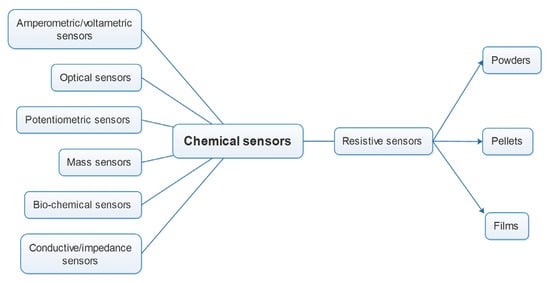
Figure 1.
Types of chemosensors used in modern practice.
(1) sensors measuring electrical or electrochemical properties;
(2) sensors measuring a change in a physical property;
(3) sensors based on optical absorption.
In the Introduction section, we referred to the concept of continuously monitor the composition of the surrounding gaseous atmosphere, in order to prevent accidents at work or at home, using sensors.
Gas sensor technology is continuously evolving; currently there are a multitude of detection methods that depend on the involved sensing principle. Gas detection is based on the fact that the changes that occur in the gaseous atmosphere modify the properties of the sensor in a characteristic way [4,6,7]. There are lots of detection techniques (Figure 1) that involve the modification of some characteristics of the sensor, but by far the most accessible, from an economical point of view, is the one that involves gas detection using a resistive-type sensor. The detection principle of these sensors is simple: the sensor reacts with a target gaseous species (analyte), from the atmosphere in which the sensor is placed, a REDOX-type catalytic reaction takes place between the sensitive material of the sensor and the target gas, accompanied by a change in the number of free electrons involved in the reaction. This results in a change of the electrical resistance of the sensor’s sensitive material which can be a powder, a compressed powder (pellet), or a film (thick or thin) deposited on an appropriate support. The sensitive material can be chosen depending on the type of application for the sensor itself (industrial, laboratory, or domestic applications), as well as the sensor operating conditions (anoxic atmosphere, normal breathing atmosphere, high or low operating temperatures, etc.).
To study the sensing mechanism, the change in electrical resistance can be detected using “widely available” electronic equipment (example: a digital multimeter or an RLC bridge for precision measurements), with a purchase bill in the hundred or thousand dollars range. Think about the retail price of a gas chromatograph coupled with a mass spectrometer, a complex setup that ensures the precise detection of all gaseous species inside a gas-mixture, in the frame of a specialized laboratory. International shipping bills, customs fees, a specialized software, periodic maintenance through a subscription (dozens of man-hours sometimes) must be also taken into account. Unfortunately, the economic aspect is of paramount importance nowadays in most domains, so an efficient detection equipment is currently defined by a compromise between fabrication costs, device reliability, and mass production availability.
Because of their advantages upon classic investigation techniques, sensors are already successfully used in various domains [8], some of which are described in Table 1.

Table 1.
Sensors applications in various domains, adapted from Ref. [9].
2.2. Sensor Characteristics
The most important characteristics used for chemical sensor description, sensitivity and selectivity, are unique and significant, as applied to the detection of chemical species. Other criteria common to all sensors, such as stability, repeatability, linearity, hysteresis, saturation, and response time, are also important for complete sensor characterization.
Jacob Fraden [3] best defined the meaning of those two key sensor characteristics in his handbook as follows:
“Sensitivity describes the minimal concentrations and concentration changes (then referred to as resolution) that can be successfully and repeatedly sensed by a device.
Selectivity describes the degree to which a sensor responds only to the desired species with very little or no interference from other species. For this reason, one of the most important characteristics of a sensor chemical, key in evaluating its performance, is selectivity” [3].
Since chemical sensors are used for both detection and quantification, they must be sensitive and selective for a certain gas species within a mixture. Ideal gas sensor use in modern-life applications must also be characterized by high stability and must offer reliable information about the monitored gaseous environment over and over again (during its life cycle, which can be measured in years).
In short, high-quality sensors must be characterized by high 3S parameters (sensitivity, selectivity, and stability) [10]. Another must-have feature is the short response-recovery time (in the seconds or few minutes domain) regarding the interaction with the analyte, in order to alert the personnel early about a potentially dangerous situation, which implies taking action immediately (building evacuation, fire control, etc.).
2.3. Use of Gas Sensors along History
The first steps in the field of gas sensors were taken by Wagner and Hauffe in the year 1938 [11], who discovered that gas molecules can react with semiconductor surfaces, influencing their surface properties [12]. The sensing phenomenon was discovered in 1952 by Brattain and Bardeen, who proved that in the case of a thin film of semiconductor material, the surface-adsorbed gas molecules modify the electrical conductivity [13]. Studies were continued by Heiland (1954) [14], Morrison (1955) [15], Seyiama (1962) [16], and Shaver (1967) [17], followed by “a major leap” in the 70s, with the appearance of the first resistive gas sensor for practical applications, patented and fabricated in 1970 by Naoyoshi Taguchi [18] (the so-called TGS sensor or Taguchi gas sensor, manufactured at that time by Figaro Inc., Mino, Japan [12]). In his detection device, Taguchi used the phenomenon of electrical resistance variation upon the oxide surface interactions with various gases. He chose tin dioxide (SnO2) as a gas sensitive material, to avoid oxidation in the atmosphere and others possible reactions, SnO2 being almost chemically inert. This choice led to circumventing the problems encountered until then when using semiconductors, such as the change of device parameters over time due to oxidation (e.g., in the case of germanium). Using a compressed SnO2 powder instead of a single crystal, Taguchi further improved the sensitivity of the device. Taguchi’s sensor is represented in Figure 2. Photographs of commercially available TGS-based sensors can be seen in Figure 3, the last photo in the series being a sensor with the protective cap removed.
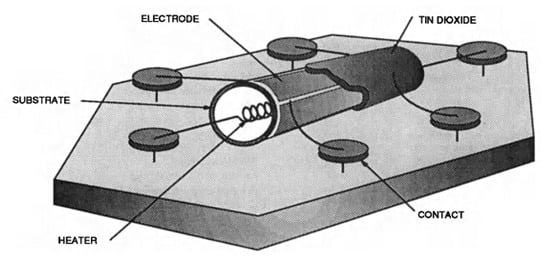
Figure 2.
The structure of a Taguchi gas sensor, from Ref. [19].

Figure 3.
Modern commercial TGS-based gas sensors photos, from Refs. [20,21,22].
As previously mentioned, the Taguchi device contains a compressed SnO2 powder, that surrounds a heating element connected to two electrodes. Taguchi discovered that SnO2 has a maximum gas sensitivity in the temperature range of 170–230 °C (the working temperature for this sensor, usually denoted as Tw), the built sensor being finally equipped with a heating element. When the semiconductor material in the sensor was exposed to gaseous atmospheres containing species, such as H2, CO, gasoline, or alcohol, its resistance decreased, and it triggered an alarm in an external circuit. The applications of these devices manufactured by Figaro Inc. included the use as fire detectors in domestic residences, as they were capable of monitoring levels of explosive gases. Despite the obvious advantages, such as high sensitivity, low cost, and a simple design, they had an inherent disadvantage, namely the lack of selectivity [19]. False alarms were often triggered when these sensors were in use.
2.4. Modern Gas Sensors
The modern gas sensors are generally TGS-based detecting devices.
The modern sensors in use have a number of advantages over classic sensors: small dimensions, low energy consumption, low manufacturing costs and large-scale production capability. The electronics of the measuring circuit and controls can also be included into the micro-sensor, thus achieving the portability of the whole detection device: the sensor, the data acquisition system, and the control system [3]. Recently, silicon substrate-based sensors were introduced [20], containing sensitive layers of SnO2 (doped or undoped), having applications in the detection of various gaseous species, such as hydrogen (H2), CO, and various hydrocarbons. ZnO and TiO2 in doped or undoped form have also been used in the detection of oxygen (O2), H2, volatile organic compounds (VOC’s), etc. The electrical properties of these sensitive oxides change with the absorption and reaction of gases on the sensor surface or in its volume.
Apart from gas sensors that can detect a certain analyte in a gaseous mixture, with a certain sensitivity/selectivity, which are specific to the sensor itself, we can mention a special class of gas sensors, namely specific sensors—dedicated to the detection of certain gases.
Methane (CH4) sensors are used on a wide-scale for gas leak detection in domestic applications.
Medical and food sensors include the ability to differentiate odors, which is used to distinguish between various investigated samples. A typical example of this is the difference made by the sensor between infected or uninfected medical samples and altered or edible food.
Single-gas sensors are a special class of sensors, which can be used directly as fire detectors, gas leak detectors, to monitor the concentration of dangerous gases (CO or nitrogen dioxide—NO2) in the work space, or for the control of ventilation in cars and airplanes [4]. It is known that in the event of a fire, the CO level increases significantly before the escaping smoke is detected by the smoke sensors. In this case, a CO sensor can provide a much quicker warning. Table 2 shows the maximum concentration values allowed for harmful gases (these may vary according to the ecological norms of the country in question) in the work environment, in the air, etc.

Table 2.
Typical values for pollutants in air [4].
2.5. Sensitive Material Deposition Techniques Used in Modern Practice and Solutions Considered for Sensor Improvement
The deposition methods for the sensitive material on a certain support are very varied. Modern sensors usually contain a thick or thin sensitive film, deposited using appropriate techniques. Thick film sensitive layer sensors have a relatively large deposited layer thickness (from a few microns to several hundreds of microns). Due to the high porosity of the sensitive layer, a large specific surface area is exposed to the interaction with the gas. Sensors with a thin film sensitive layer are compact, having a deposited layer thickness in the order of nanometers (a maximum of several hundred nanometers). Within the technology of sensitive films, the deposition methods most often used are [23]:
- chemical vapor deposition (CVD), achieved by laser induction, plasma activation, photon activation, laser pyrolysis, etc;
- physical vapor deposition (PVD), achieved by thermal evaporation, electron or ion beam evaporation, and reactive evaporation;
- spray pyrolysis—involves a sequence of processes that take place sequentially or simultaneously including the generation of aerosols, evaporation of the solvent, deposition in uniform layer of droplets, and decomposition of precursors.
These deposition techniques require a very complex specialized equipment, constituting a major economic disadvantage in the strategy of the construction of a new sensor with commercial applications.
The cheap and also more ecological alternative solution used by the authors of this review is the preparation of the sensitive film using sol-gel technology, combined with a deposition by dip-coating (soaking or immersion) or spin coating. The sol-gel method essentially represents the synthesis of an amorphous inorganic lattice (at least in first stages) through chemical reactions, in solution at low temperatures. In the case of the dip-coating method, the substrate (support) of the sensor (usually a ceramic-type wafer) is immersed in a colloidal solution which contains the precursors from which the sensitive material is prepared. This method involves the subsequent stabilization of the deposited film by heat treatment. Sol-gel technology, combined with a dip-coating method is a low-energy process causing an overall low level of pollution (eco-friendly), with the stabilization of the deposited films taking place at low temperature (in this work the maximum temperature used was 350 °C), thus being considered an ecological method of preparing the sensitive layer. The sol-gel technology allows easy control of the number of deposited layers (thickness of the film), of the concentration of the precursor solutions, of the dopants, and the type of support for the deposition of the sensitive film. The main disadvantage of this technique is the instability of the obtained sensitive films over time. In the case of the deposition method by spin-coating, the colloidal solution is cast on the substrate while it rotates at a certain speed to ensure a uniform distribution of the film on the surface, using centrifugal force. After the corresponding film thermal stabilization stage (in this work the maximum temperature used was 400 °C), it was observed that this preparation method led to more stable sensitive thin films. The optimization of the sensitive materials obtained by the sol-gel method can be achieved by their chemical modification during the preparation process, carried out by doping or by adding more oxide components (a composite sensitive material is obtained). Thus, the specific properties of the component oxides can be combined, obtaining a sensor with improved properties (lower operating temperature, increased sensitivity and selectivity, increased chemical resistance, higher stability over time, lower electrical resistance base-values, etc.). Another method of sensor improvement was optimizing the transducer design, namely the metallic electrodes configuration or the ceramic wafer thickness, aspects which will be discussed in detail in the following sections of this review.
2.6. The Detection Principle for Resistive Gas Sensors
As previously discussed in Section 2.1 of this review, resistive-type sensors usually contain sensitive metal oxide materials (MOX) in the form of powders, pellets, or films deposited on a substrate. The electrodes and the electrical connections belonging to the measuring circuit are specific to the type of sensitive material used in the sensor. Currently, the number of potential applications for gas sensors is very high, covering a very wide range of marketed products, from relatively large devices, such as the ventilation control device in automobiles, to miniaturized devices, such as single-gas sensors.
The gas-solid interaction, which is the basis for the detection principle, may be classified as follows:
- processes that take place on the surface of sensitive material;
- processes that take place at the intergranular barrier;
- processes that take place between the sensitive layer and the sensor electrodes.
These processes determine the total electrical resistance of the sensor [4]. The total resistance of a polycrystalline gas sensor will be a function (Equation (1)) that depends on the specific volume resistance ρb (resistivity) and sensor components resistivities, which may be affected by the surrounding gases: the nanocrystal surface (ρS), intergranular barriers (ρgb), and sensitive layer -electrode contacts (ρc) [6].
The conductivity σ of a semiconductor crystal belonging to the sensitive material can be described as the sum of the conductivities: electronic, protonic, and ionic, if the conduction processes are considered to be independent [4].
Usually in the case of thick film sensors, the sensitive layer has high porosity and consists of a network of interconnected nanometric-size particles of oxide material.
In the case of thin film sensors, the sensitive layer is continuous and compact. Consequently, the volume of the sensitive layers is inaccessible to gases and the interaction takes place only at the surface of the sensor.
Figure 4 shows schematically the interaction of a sensitive film (denoted in the cited reference [24] as “layer”) with the target gas.
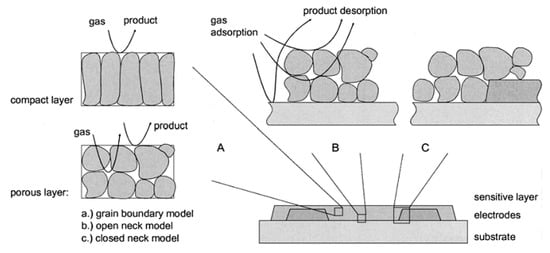
Figure 4.
Sensitive layer-target gas interaction, in the case of a resistive gas sensor, from Ref. [24].
The factors that influence the total electrical resistance of the sensitive material (see Equation (1)) may change depending on the working conditions. As it will be shown in the following sections, if electrical measurements are performed on a powder-type sensitive material, in alternating current at a certain low value frequency, the intergranular and volume components become negligible, the response of the sensor being determined exclusively by the interactions taking place on its surface [9].
The principle of sensing, when a chemiresistor is used, involves measuring the electrical resistance changes in the sensitive material upon target gas exposure. If the sensing experiment unfolds under environmental conditions (the atmosphere in which the sensor is placed contains mostly air) the surface of MOX-based sensitive material adsorbs oxygen as different species: O2−, O−, or O2− (depending on the working temperature).
In the first stage of gas sensing, a chemical reaction takes place between the target gas molecules and the adsorbed oxygen species on the surface of the sensing material, followed by a significant change of resistance, detectable using calibrated electronics. The second stage of the sensing process consists of transforming the electrical signal into another type of information (e.g., the concentration of the analyte [25]) which can be processed by an analog-to-digital converter, in order to trigger an alarm in a separate circuit. This represents the simplified view of the sensing mechanism for this type of gas sensor. For n-type semiconductors, the overall sensor electrical resistance increases after exposure to oxidizing gases or decreases after the sensor is exposed to reducing gases. For p-type semiconductors [26], the electrical changes are reversed in comparison with n-type semiconductors, upon exposure to oxidizing or reducing gases [27].
2.7. MOX-Based Sensitive Materials Used in Own-Design Gas Sensor Prototypes
The literature covering the study of MOX-based resistive sensors is extremely vast. The most encountered sensitive materials in gas sensing literature are: tin oxide, zinc oxide and titanium oxide. The high number of research papers involving these materials is in close connection with the fact that they are abundant in nature (low production costs). On the other hand, their electrical properties as semiconductor materials are well known in the present, due to their intensive study in the past. However, gas sensors containing only one of these oxide components are highly disadvantaged due to: high working temperatures (a very undesirable feature because it involves a high energy usage), expensive preparation techniques (CVD, PVD, spray-pyrolysis, and screen printing), low specificity for a certain gas (which implies non-selective sensors), a characteristic that can generate false alarms and panic.
Tin oxide (SnO2) is the most studied among the existant sensitive materials involved in resistive gas sensor fabrication. In a doped or non-doped form, it presents a high sensitivity for a wide range of gases, among which we can list: CO, ammonia (NH3), nitrogen oxides (NOx), CH4, propane (C3H8), ethanol (C2H5OH), H2, H2O, H2S, and volatile organic compounds (VOCs) [23]. The detection of these gases is non-selective (in most cases), the sensor response being the same if more than one of these gases are present in the investigated gaseous atmosphere. The working temperature of this material (the temperature to which the oxide material must be heated in order to become sensitive to that target gas) is currently considered too high (500–1000 °C) for current energy requirements.
Zinc oxide (ZnO) is the second most studied material in the field of resistive gas sensors, after tin oxide. The structural defects characteristic of this oxide influence the sensor mechanism through which the detection process takes place (major changes in the conductivity of the oxide due to the presence of these defects). ZnO can detect O2, ozone (O3), H2, CO, and short-chain hydrocarbons, but its electrical response is not as pronounced as that of SnO2, its selectivity is low, it is sensitive to humidity and has issues with long term stability [23]. Its combination with SnO2 is known to detect CO according to the research presented in Ref. [23]., but the high value for the low limit of detection (200 ppm) is unsuitable for current sensor requirements (at least 5–10 ppm), even though the working temperature is lower (200–600 °C) than for pristine SnO2.
Titanium oxide (TiO2) has two very distinctive characteristics as a pristine sensitive material: very high working temperatures (800 °C) and high electrical resistance (in the MOhm range). Due to these drawbacks, working with pristine TiO2 in actual sensors has proven to be difficult. Among its current applications we can mention oxygen detection in the automotive industry [23]. The working temperature and electrical resistance of sensors based on TiO2 can be reduced by doping with various materials. Comini et al. [28] reported the sensitivity of TiO2 films doped with Nb and Pt (prepared by the sol-gel method) for ethanol and methanol, but their sensitivity to CO was not reported. The detection of other gases (NO2, O2, C3H8, and NH3) was also achieved with sensors that are obtained through expensive technologies (CVD deposition, PVD, and screen printing) [23].
Cobalt oxide (CoO) is the most stable as Co2+. In gas sensors, CoO is considered a promising material for the detection of NH3, VOCs, and hydrocarbons at low temperatures, starting with room temperature [23]. Although they are advantaged, from the energy-use point of view, these sensors are yet to be fully characterized.
The studies carried out by the authors of this review are based on these raw materials, but the authors managed to solve in the frame of their workgroup (as members of national and international research grants) some of the issues specific for these sensors, described in the literature by other researchers, by finally creating an improved sensor, optimized in terms of working temperature, sensitivity, stability, and selectivity for a certain gas, and also to keep the costs low when developing the actual gas sensor. Several ISI articles were published by the authors workgroup (several members are presented in the Acknowledgements section) during 2013–2022, based on this research.
3. Results and Discussion
3.1. Powder Type-Sensitive Materials Used for CO Detection
Our group began experimenting (Figure 5 and Figure 6) with commercial TiO2 powders (Rhone-Poulenc), used previously for in-situ conductivity experiments alongside with the whole experimental setup (gas cylinders, gas lines, mass-flow controller system, and own-design conductivity cell) constructed for that purpose. We figured, instead of determining punctually the electrical conduction G of the material exposed to gas within the cell, as required by the in-situ conductivity experiments protocol, why not record the G values continuously instead, using a Labview-based own-designed computer software. Basically, the experimental conditions were the same: continuous gas flow, inert atmosphere (to ensure oxygen non-interference), and a predetermined CO gas concentration obtained by calibrated MFC’s to be injected into the system.
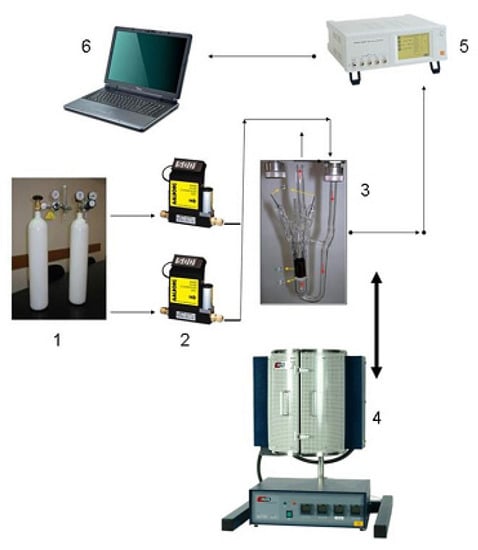
Figure 5.
Gas-sensing experimental setup used for powder-type sensitive samples, with (1) carrier and target gas cylinders, (2) MFC system, (3) gas sensing cell, (4) programmable furnace, (5) RLC bridge, (6) data acquisition computer, from Ref. [8].
An alternative current of 1.5 V was applied to the conductivity cell electrodes, considered as the sensor operating voltage, at a fixed frequency of 1592 Hz, to ensure sensitive material surface response only [29,30].
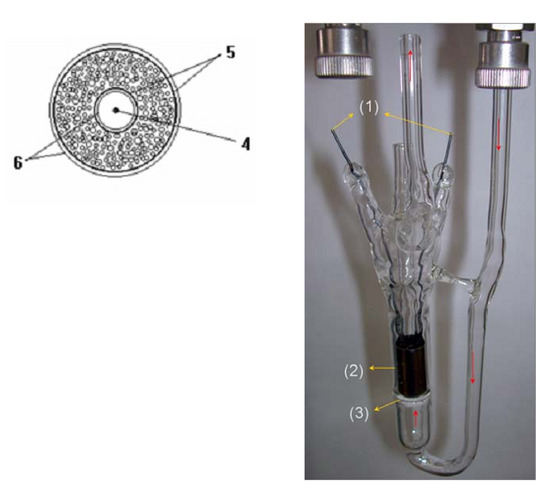
Figure 6.
The own-design sensing cell utilized with powder samples, with (1) tungsten wires, (2) coaxial tantalum electrodes (cylinder type), (3) ceramic frit, (4) thermocouple (slice view), (5) coaxial tantalum electrodes (slice view), and (6) glass walls (slice view), from Ref. [31].
The sensitive TiO2 powder was inserted (supported on a ceramic frit) into the conductivity cell having cylindrical-type tantalum electrodes; these two key components constitute the sensing device, with a metal-to-ceramic type of connection between the cell’s electrodes and the sensitive material. Thus, the first gas-sensing protocol was conceptualized in the frame of our workgroup, determining G values in a non-oxygen gas environment (helium atmosphere), for a commercial powder sample of TiO2, exposed to different CO concentrations (250–2000 ppm). CO is a product of incomplete oxidation of organic matter [32], that appears as a result of the lack of oxygen necessary for performing complete oxidation to CO2. CO is present in the environment in high concentrations in the underdeveloped regions of the planet, where solid fuel combustion is still used intensively, as well as in traffic-congested cities, with a high level of pollution produced by engines with internal combustion. As mentioned before, the constant monitoring of CO levels in the indoor/outdoor environment is of paramount importance [33,34,35].
Surprisingly, the initial sensing results were astonishing. For an experimental setup initially designed with an entirely different purpose, a very strong sensor signal was recorded, with very well-defined response/recovery sensor characteristics, and an incremental sensor signal response when the gas concentration was increased from 250 to 2000 ppm (Figure 7).
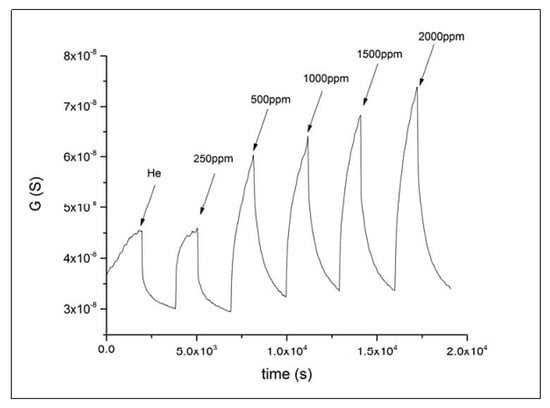
Figure 7.
TiO2 sensor response/recovery characteristics, at a working temperature Tw = 400 °C, from Ref. [31].
It can be clearly seen in Figure 7 that for an entire sensing cycle of 3000 s, for all the tested gas concentrations, the sensor is highly responsive, its recovery being complete after each tested concentration.
A two stage sensing mechanism [36] was formulated, describing the reduction of TiO2 and the CO oxidation on the surface of the TiO2, using oxygen from the TiO2 lattice. It must be mentioned that the commercial TiO2 powder was still covered by the warranty at the time it was used for sensing measurements, but it had a shelf-life of at least a few years. The results reported by the authors in this study were cited by recently published ISI papers [37,38].
This covered the "as-is" raw materials found in our laboratory. However, what about if we could perform our own synthesis? What can be improved in this way? We kept the experimental setup, we kept the target gas and the gas-sensing protocol, and we changed the sensitive material composition.
To this goal, a SnO2-CeO2 series of mixed oxides was prepared (5–20% wt SnO2) by the co-precipitation method, using commercially available reagents (from Interkemia). However, why choose this particular oxide combination? Well, the state-of-the-art stated at that time (2015) that SnO2 was one of the most used sensitive materials in chemosensors, but “its activity and electrical response to the ambient were limited by its low surface area (only a few m2/g)” [39], and “SnO2 deposition on higher surface area supports like γ-Al2O3 or TiO2 or even rare earth oxides (CeO2) influences the activity/electrical response” [40,41,42,43,44,45]. On the other hand, CeO2 had too high working temperatures (in the 700–1000 °C range) to be used as pristine sensitive material [46,47,48,49,50,51,52]. Using a composite sensitive material instead of pristine oxides should overcome the disadvantages presented by each separate oxide component [53,54,55,56].
Again, the sensing experiments unfolded without issues, strong sensors signal response was recorded (Figure 8), and it was observed that the sample containing the least amount of SnO2 (5%) is the most sensitive to CO (Figure 9), in the absence of oxygen (helium atmosphere), at a working temperature in the 400–450 °C range. The principle of detection is following the Mars van Krevelen mechanism (verified with EPR measurements [57] on the sensor samples, before and after sensing experiments, see Figure 10–Ce3+ paramagnetic species generate characteristic spectral lines, proportional in intensity with the species concentration in the investigated sample), with CeO2 reduction and CO oxidation on the powder surface [24], also involving the use of lattice oxygen supplied by CeO2, which acts as an O2 tank [51,58] in the sensing process.
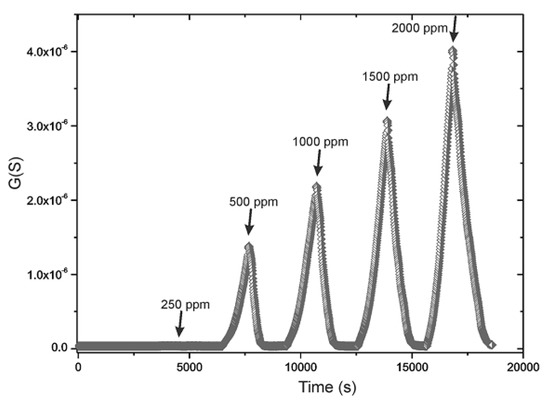
Figure 8.
5% SnO2-CeO sensor response/recovery characteristics at Tw = 400 °C, from Ref. [40].
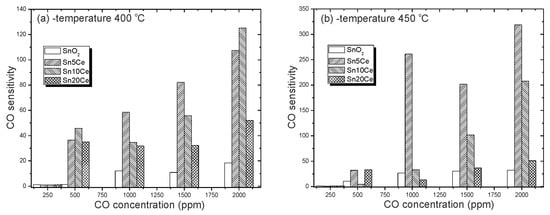
Figure 9.
SnO2-CeO2 sensor series sensitivity to CO at corresponding Tw = 400–450 °C, from Ref. [40].
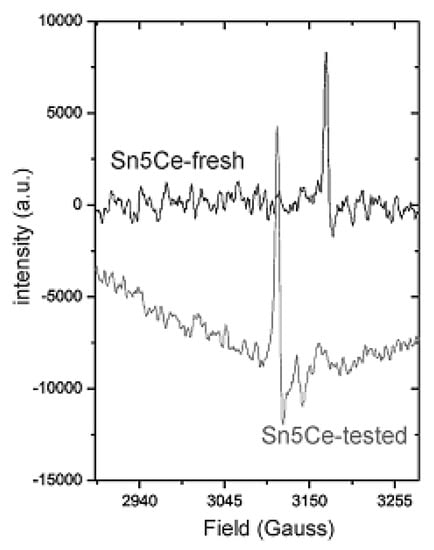
Figure 10.
5% SnO2-CeO2 sensitive powder EPR spectra, taken before and after sensing experiments, from Ref. [40].
Moreover, comparing Figure 7 and Figure 8, it can be observed that the prepared composite oxide sensors have a sensing performance with two orders of magnitude higher than the commercial sample of TiO2. The higher sensitivity to CO was attributed mainly to the high porosity of CeO2 [48,49].
The surface morphology of the two types of investigated powders (TiO2 and the composite Sn-Ce sensors) seem to be similar (Figure 11 and Figure 12): we deal with polycrystalline powders, containing nano-sized particles, having the tendency to agglomerate, forming clusters.

Figure 11.
SEM image of the TiO2 sensitive powder sample, from Ref. [31].

Figure 12.
SEM image of the SnO2-CeO2 sensitive powder samples with: (a) 5%SnO2; (b) 10% SnO2; and (c) 20% SnO2, from Ref. [40].
In Table 3 the surface area values [59] of the investigated powder-type sensors are presented.

Table 3.
Surface area of the investigated sensitive powder-type samples.
It can be seen that, even if commercial TiO2 has a superior surface area compared to the values obtained for the prepared SnO2-CeO2 mixed oxides, it yields a sensor response for CO that is two orders of magnitude lower. As stated before, the CO sensing mechanism is similar in both cases, making use of lattice oxygen from the sensitive oxide lattice, in an atmosphere without oxygen. The use of composite sensors clearly has its advantages over the use of pristine oxides in gas sensors when dealing with powder-type sensitive materials. A very important aspect that must be mentioned here regards powder-type sensor stability: the samples were prepared in 2007 by Dr. Yuzhakova (co-author to the cited paper [40]) in the frame of a bilateral cooperation project and used at that time as an environmental catalyst. The sensing measurements over these composite samples were recorded in 2013. Six years after synthesis, they responded when exposed to CO, as seen in Figure 8.
Regarding the high 3S parameters required for a sensor to be considered for commercial applications, the powder type sensor-systems tested by the authors fulfill only two out of three: they are highly sensitive and extremely stable. Selectivity measurements were not performed on the powder-type samples, as the authors main goals at that time (2012) were to prove that an experimental setup built for in-situ conductivity measurements (catalysis) may be adapted and used for gas-sensing experiments.
The main disadvantage when the authors dealt with this category of gas sensors was related to the large quantities of sensitive material used in the sensing device, measured at 1.5 cm3 in both sensing experiments.
To conclude this section, we can state that the powder-type sensitive compositions tested by the authors are very promising as gas sensors due to their excellent reliability and high sensitivity, but they are suited for applications that may involve the absence of oxygen (e.g., fuel-cells), and large quantities of sensitive materials (e.g., industrial applications). Additionally, the use of alternative current as sensor operating voltage poses an impediment because it needs additional electronics which may affect detection device portability. The authors findings in this study were cited by several ISI papers [61,62,63,64,65,66,67,68].
3.2. SnO2-ZnO-Based Pellet-Type Composite Chemiresistors Used for Selective Detection of CO
By compressing the oxide powders into a pellet, the disadvantages encountered when using sensors with powder-type sensitive materials may be eliminated (e.g., lack of selectivity). So the logical next step was to reduce the volume of sensitive material in size, and to check the sensing performance of the resulted sensor upon target gas exposure.
In order to accommodate the new sample type, the experimental setup was modified accordingly (Figure 13): the own-designed sensing cell from the previous setup was replaced with a special cell used for impedance measurements (Probostat cell, equipped with the 2-point standard kit, used for pellet samples conductivity measurements).
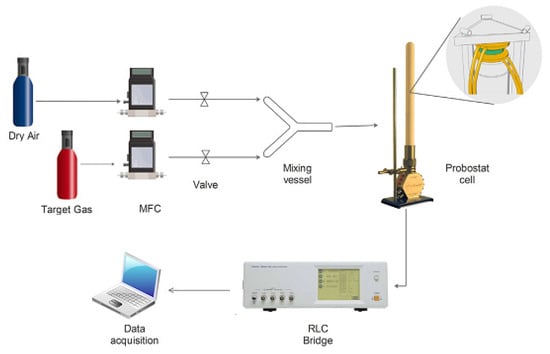
Figure 13.
Gas sensing experimental setup used for pellet-type samples, from Ref. [69].
The sensitive metal oxide pellet together with the Probostat cell represent in this case the gas sensing device. New measuring equipment involved a modified gas sensing protocol. The previously G recorded values were replaced by electrical resistance R values, a new type of sensor operating voltage was applied to the sensitive material (1.5 V direct current, instead of alternative current) and a new type of connection between the sensitive materials and the sensing cell electrodes was introduced (metal-to-metal, for superior electric conductivity). The sensing environment was changed from an inert atmosphere to laboratory conditions (dry air), cross-sensitivity measurements to other target gases (methane, propane) were also introduced to better characterize the sensor samples (chemiresistors). The previously tested concept that composite materials are better than pristine ones was once again used, and a series of bi-component oxide pellets (based on SnO2 and ZnO) was prepared and their performance in CO, CH4, and C3H8 sensing was assessed.
A new target was set regarding the sensor lower detection limit, given the fact that concentrations of CO over 35 ppm are harmful and lead to visible symptoms (headaches), so the lowest tested concentration was set at 5 ppm CO in air.
Regarding the oxide components, as previously mentioned, pristine SnO2 is widely used as a sensing material [70,71] because of its high sensitivity to multiple gases, but the lack of selectivity and high operating temperatures (500–1000 °C) are very important factors to consider when designing a new gas sensor. On the other hand, pristine ZnO has a lower gas sensitivity, although the operating temperatures are lower (200–600 °C).
The sensors used for practical applications (a warning system to the otherwise undetectable carbon monoxide) [33,34,35,72] must be sensitive, selective, and must operate at low temperatures (ideally at room temperature).
The improvement of gas sensing performance is expected when using composite sensitive materials [25,73,74,75,76,77,78,79,80,81], since they tend to be more porous (hence more accessible to target gas molecules) than the pristine oxide components. An optimal composition of ZnO and SnO2 should (in theory) improve the sensor selectivity and response to CO by combining the low operation temperature of ZnO and the high sensitivity of SnO2 [69].
To achieve this goal, a series of composite pellets was prepared by the wet homogenization of the pristine oxide reagents (from Merck), followed by a pressing process. The obtained pellet samples were cylindrical, having the following dimensions: Φ = 10 mm and h = 2–3 mm, which is a huge step forward from the 1.5 cm3 of powder samples used in the previous sensing experiments.
Although many sample compositions were prepared, with different component ratios (SnO2 quantity varied from 2.5% mol to 50% mol), the best sensor performance was recorded for the sensor containing 50% SnO2-50% ZnO, with a phase composition consisting mainly in Zn2SnO4, with a separate phase of SnO2 (sensing results were recorded after 3 years from sample preparation). The SEM-EDX analysis of the sensitive pellet showed a small excess of SnO2 on the surface of the pellet (Figure 14).
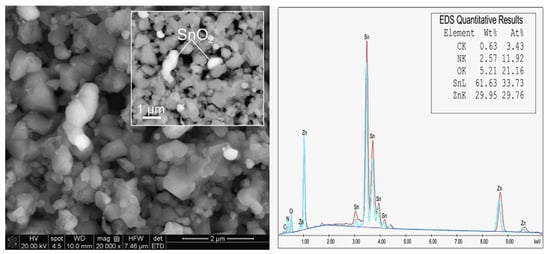
Figure 14.
SEM/EDX analysis of the 50% SnO2-50% ZnO sensitive pellet, from Ref. [69].
Adding SnO2 in the composite material leads to increasing sample porosity, which promotes CO adsorption on the surface of the sensitive material. A higher number of adsorbed target gas molecules translate into a more intensive CO oxidation to CO2, accompanied by the release of electrons in the process (the sensing mechanism for this type of sensor). The SnO2 (found as excess on the sensing surface) is well known for its capacity to adsorb oxygen [69], the other necessary reactant for the oxidation process besides the analyte.
After identifying which sensor sample is the best in the prepared batch, a silver paste coating was applied directly on each side of this pellet, thus improving the nature of the electrical contact between the sample and the sensing cell electrodes (from metal-to-ceramic to metal-to-metal), thus lowering the detection limit of the sensitive material from 250 ppm to 5 ppm CO.
Sensor response was defined as:
where Rair = the electrical resistance of the investigated sensor in carrier gas and Rgas = the electrical resistance of the investigated sensor in target gas.
It can be seen from Figure 15 that when the sensor comes into contact with the target gas (CO), it responds instantly (a very steep increase in sensor signal is recorded each time a target gas injection is performed). This is another direct consequence of the improved electrical contact between the sample and the electrodes belonging to the sensing cell.
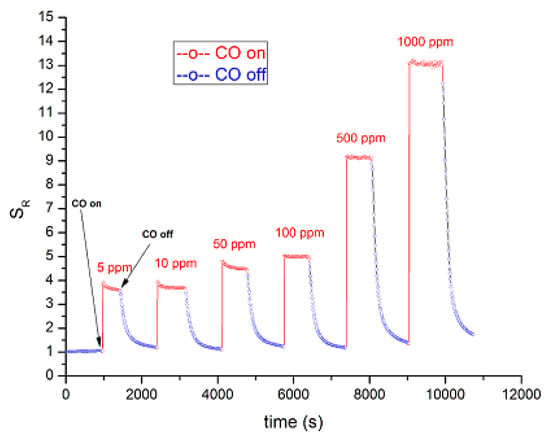
Figure 15.
The response-recovery characteristics of the 50% SnO2-50% ZnO sensor at Tw = 500 °C, from Ref. [69].
Sensor response time was estimated at approximately 60 s (compared with 1500 s in the case of powder-based sensors. Figure 15 showed a stable response for the investigated sensor when exposed to CO (the response curve reaches a flat plateau for each tested concentration). The sensor was also characterized by a complete recovery (15 min), with the response values returning to the baseline after finalizing each target gas injection cycle. The sensor in question was capable of being re-used after the recovery stage for a new sensing experiment, without replacing the sensitive pellet in the sensing cell. Up to this point, two out of three high-S sensor parameters were achieved: sensitivity and stability.
How about sensor selectivity? As stated before, neither pristine SnO2 nor ZnO excelled in this topic. Cross-sensitivity measurements with methane and propane were performed next (each target gas was tested separately).
The response of the investigated sensor to the potentially interfering species was as follows:
- for C3H8, it is 2.8 times lower than the sensor response to CO;
- for CH4, it is 5 times lower than the sensor response to CO.
Figure 16 demonstrates that the investigated sensor is selective for CO. With this sensor being characterized by great reliability and high 3S parameters, it is considered to be promising for the future development of a fire-hazard sensor used for industry and/or domestic applications. The work performed in this study was cited by several ISI articles [82,83,84,85,86,87,88].
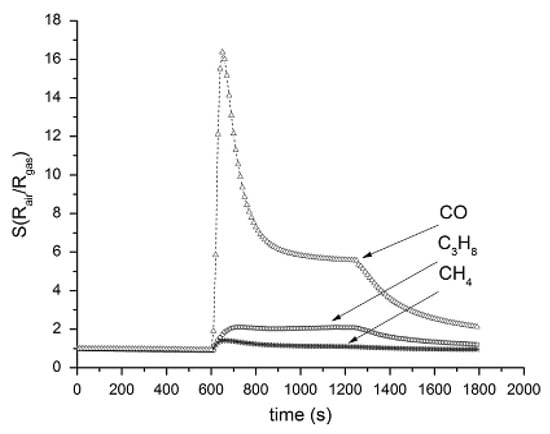
Figure 16.
50% SnO2-50% ZnO sensor response for 50 ppm CO, CH4, and C3H8 at Tw = 500 °C, from Ref. [69].
But the problem regarding the high volume of sensitive material involved still persists; even if the powder is compressed, we still talk about a few grams of material per pellet.
The next stage would be to reduce the dimension of the sensitive device even further, thus our group switched to sensitive films deposited on ceramic supports (plain or with included metal electrodes), which is discussed in the up-coming sections of this review.
3.3. Sol-Gel Based Thin Film Sensitive Materials Used in Gas Sensors
3.3.1. Nb-Doped TiO2 Thin Film Sensors Used for Detection of CO
Although the sensitive materials discussed in the previous sections are perfectly viable from a functional point of view, they are suitable for applications where usually “more is better”. However, the trend of any type of application in any domain for the last decades was to reduce the cost of fabrication and the dimensions of the detection device [8]. The most representative example is provided by microelectronics, where “less” meant “higher” performance; with the invention of integrated circuits, more components were inserted on a “chip”, this being translated into lower costs and energy consumption. In this section, the concept “less is better” was tested to its limits, in every possible way: less sensitive materials (thin sensitive layers in the nanometers thickness range), miniaturized sensors (millimeters in size), lower detection limits (starting with 5 ppm), etc.
The authors thus entered the thin films domain, by initially testing a sensitive film deposited on a plain ceramic support. To achieve this goal, a thin film of TiO2 doped with niobium (Nb) was deposited onto a microscope glass substrate (the sensitive film contained 1–10 deposited layers), using the sol-gel/dip-coating technique. The used precursors were tetraethylorthotitanate [Ti(OCH2CH3)4], niobium ethoxide [Nb(OCH2CH3)5], and ethanol (C2H5–OH) as the solvent. As a chelating agent, 2,4-pentanedione was used.
Nb acts as a donor, as it increases the number of charge carriers, narrowing the bad gap and lowering the TiO2 base-line resistance; another role of Nb is as a phase-shift inhibitor (from anatase to rutile) [89].
Titanium oxide is well known for its high chemical stability at elevated temperatures [90,91], turning this sensitive material into an option for durable gas sensors.
However, pristine TiO2 (anatase form) is known for its high base-line electrical resistance [92,93], in the Mohm range, a non-desirable feature for applications. Doping the titania matrix with different transition metal, such as Nb, can be considered a viable option, as it decreases TiO2 electrical resistance, enhances gas sensing performance, and creates new structures for titania by preventing the anatase to rutile transition, or even alters the pores and particle dimensions [94,95,96,97].
The state-of-the-art of the referenced paper [89], regarding CO detection using Nb-doped TiO2 films, cites a few reports found in literature on CO sensing using Nb-doped TiO2 (denoted as TiO2:Nb). Zeng et al. [95] used hydrothermally-obtained TiO2:Nb thick films for VOCs sensing, with Nb promoting the gas sensing performance of anatase. In Ref. [98], high surface area nanorods were used to detect ethanol or LPG at a Tw of 450–550 °C. Sharma et al. [99] have reported a 65 times sensitivity increase towards oxygen by doping TiO2 with Nb, as well as a decrease in response time (from 28 s to 3 s) and Tw (from 600 °C to 400 °C). Moon et al. [90] used nanostructured TiO2:Nb thin films (colloidal templates) to detect CO, with a faster sensor response compared to pristine TiO2 films, demonstrating that doping clearly increases sensor sensitivity. Gan et al. [100] deposited TiO2:Nb films (with 6% Nb) using sol–gel. Their sensing film was used to detect oxygen, with greatly improved performance in terms of sensitivity and response time.
According to the year 2016 state-of-the-art [93,96,97,101] presented in Ref. [89], the TiO2:Nb films were mainly prepared using physical methods such as radio-frequency sputtering [102,103], pulsed reactive magnetron sputtering [104], electron beam evaporation [105], atomic layer deposition [106], and pulsed-laser deposition [107,108]. The sol–gel method was used in the article published by the authors [89] for the fabrication of the sensing films, in order to propose an economical solution to the other fabrication methods found in the literature, all of which are very expensive alternatives in terms of equipment costs.
The Probostat cell from the previous section was kept and adapted (Figure 17) for this type of sample (a 4-points measurements kit for rectangular samples replaced the 2-points kit suitable for pellets). The measurements were performed under laboratory conditions and continuous carrier gas flow. Target gas injections were performed for 5 min, alternating with 5 min of sensor recovery under carrier gas flow.
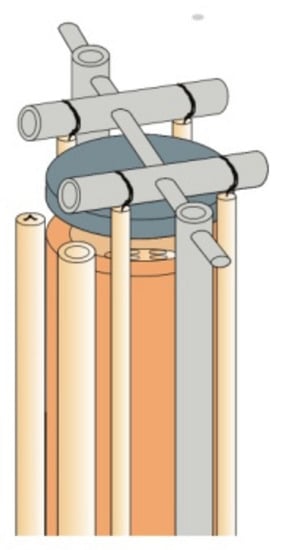
Figure 17.
Probostat 4-point measurements kit for pellets, discs, or rectangular ceramic supports, from Ref. [109].
The obtained sensitive films were characterized as thin and porous (shallow pit-like cavity shapes), with thickness in the 100–370 nm range, according to the number of deposited layers (Figure 18). The cavity dimensions on the film’s surface were in the 10–30 nm depth range [89].
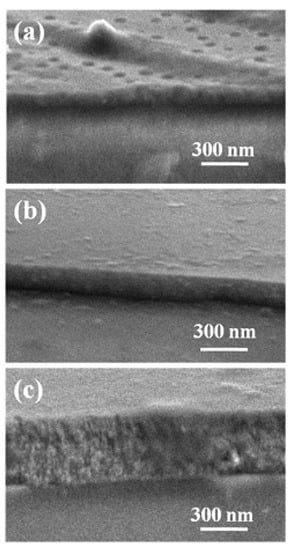
Figure 18.
SEM cross-section images of the (a) TiO2:Nb-2 layers, (b) TiO2:Nb-5 layers, and (c) TiO2:Nb-20 layers films, from Ref. [89].
Initially, a voltage of 1.5 V DC was applied to the sensitive film. The results were inconclusive in this case, with no sensor response when exposing the samples to atmospheres containing various concentrations of CO. The lack of response was attributed to the absence of printed metal electrodes directly on the surface of the ceramic support, which in this case would facilitate the transmission of the electric charge at the measuring equipment. The AC approach was used next, so a 500 mV AC current was applied to the surface of the sample, at a frequency of 1500 Hz, and the resistance values of the sensitive films were recorded automatically upon sensor exposure to different CO concentrations in the 250–2000 ppm range (Figure 19).
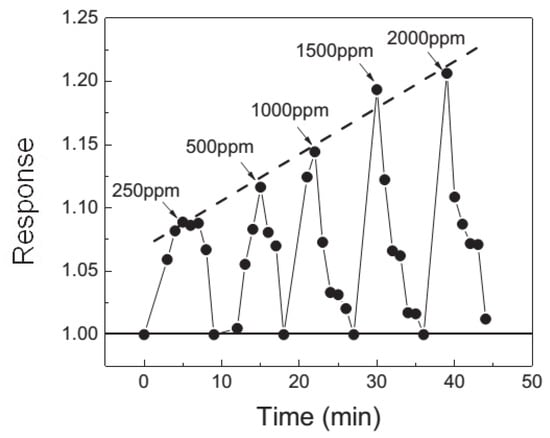
Figure 19.
Recovery characteristics of Nb-doped TiO2 (10 layers) sensor at a Tw = 400 °C, from Ref. [89].
As can be observed in Figure 19, the investigated sensor is characterized by a fast response and a full recovery (5 min). Sensor response is defined as:
with being the sample conductivity in carrier gas, and being the sample conductivity in target gas (CO).
Relatively small sensor response values (1.10–1.22) were obtained for the sensor response, but they were in agreement with the values obtained by other research groups, at the time these results were published (2016), as described in the state-of-the-art section of the published paper [89].
Regarding the involved sensing mechanism, as mentioned before, the role of Nb-doping is of a donor in the TiO2 matrix, as it pumps electrons into the conduction band, thus increasing the number of available charge carriers [110]. As a result of an increased amount of electrons in the TiO2 conduction band, more oxygen molecules will be adsorbed onto the sensing film surface, yielding more reaction sites available for CO oxidation compared with the undoped TiO2 [89]. These statements are verified in practice, the doped sensor samples having better sensitivity to CO than the pristine TiO2 sample. Sample sensitivity represents in this case the ratio between the electrical resistance of the sensor placed in carrier gas (Rair) and the electrical resistance of the sensor exposed to the atmosphere containing the target gas (RCO) (Figure 20).
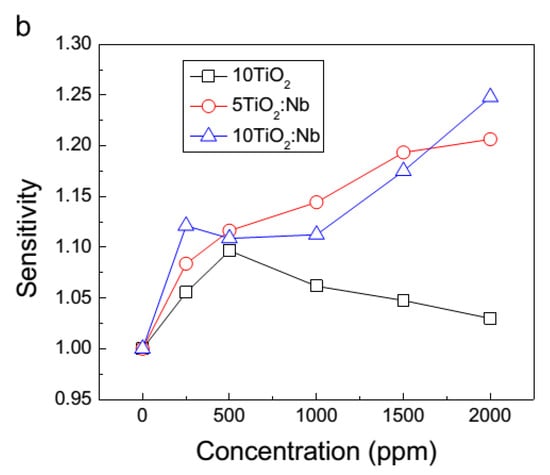
Figure 20.
Sensitivity to CO of different tested sensors (with doped or undoped TiO2-based sensitive films) at Tw = 400 °C, from Ref. [89].
According to Caldararu et al. [29,30] at the frequency value used by the authors in the gas sensing protocol, the bulk conductivity of the sample being negligible, the surface of the sample plays a major role in the overall conductivity of the investigated material.
Figure 20 also evidences that the number of layers do not really influence the sensing performance of the films, gas sensing being fundamentally a surface process and the 5- or 10-layered TiO2:Nb samples being similar morphologically speaking [89].
Up to this point, it can be observed that two different sensor characteristics are being referred to in the text: response and sensitivity. Many authors confuse these terms, but according to IUPAC [111] it is a clear distinction between the two: sensor sensitivity represents the sensor response as a function of analyte concentration or amount.
Comparing the results depicted in the state-of-the-art section of the cited article [89], it can be observed that comparable sensitivity and working temperature values were obtained for the Nb-TiO2-based investigated sensors, but a major leap was taken regarding the preparation technique of the sensitive films: they were deposited via the sol-gel method, an eco-friendly/cheap technique, and a key factor when the “mass-production” concept is involved.
The factor that indeed needed improvement was the value of the sensor response (1.10–1.22), which is in close connection with the lack of metal electrodes imprinted on the surface of the ceramic support, also leading to sensing measurements performed in AC, instead of the more accessible DC-type sensor operating currents.
Reference [89] represents the authors most cited ISI paper (up to January 2023), with the most recent references being [112,113,114,115,116,117,118,119,120,121,122,123,124,125].
3.3.2. SnO2-ZnO-Based Thin Film Composite Chemiresistors for Selective Detection of CO
For the past decade, sensing device integration has been the main goal that has driven research and development in the domain of smart devices for remote sensing, for sensors based on changes in electrical conductivity [27]. Chemical resistive-type micro-sensors present a series of advantages such as: low cost compared to other sensing technologies, low power requirements, quick responses (seconds), high sensitivity to analyte trace level concentrations, and complete sensor recovery. Recently, the portability factor increased dramatically, sensors being mass-produced with reduced dimensions using miniaturization and microelectronics processing, according to the referenced papers [25,28].
The next logical step of this sensitive materials study towards sensor miniaturization was, thus, to advance to more complex ceramic supports, which are much smaller in size than a relatively large microscope glass substrate, with interdigital metal electrodes (IDEs) imprinted on the surface. An own-design transducer prototype was produced in cooperation with the National Institute for Research and Development in Microtechnologies.
As previously mentioned, a transducer is defined as an electronic device that converts (in our particular case) the energy released during a chemical reaction into an electric signal.
A schematic presentation of the alumina transducer (with an alumina wafer from Kyocera) is given in Figure 21 and Figure 22.
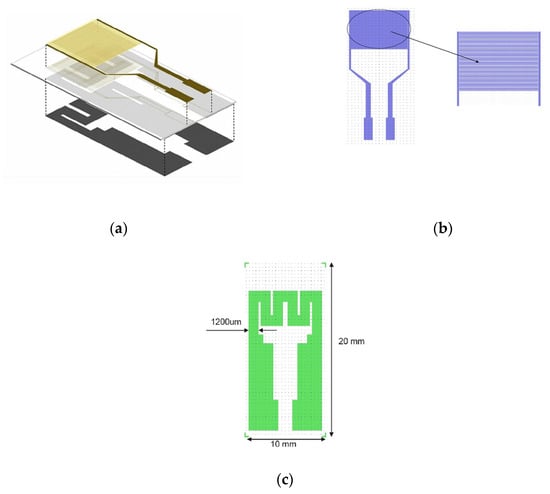
Figure 21.
The alumina transducer schematic representation with (a) the overlay of the IDE and the heater; (b) gold IDE; and (c) platinum heater element, including the transducer dimensions of 10 × 20 × 0.2 mm, from Refs. [126,127].
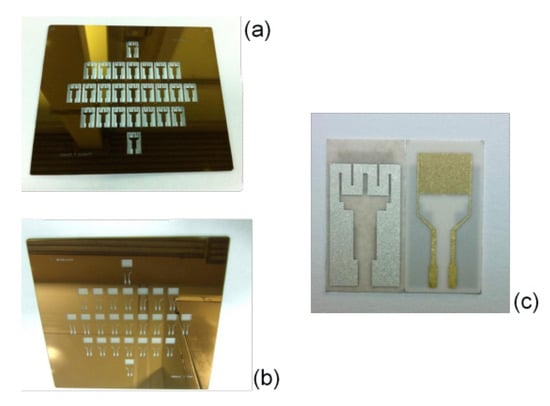
Figure 22.
(a) Masks for heater; (b) masks for IDE; (c) the transducer prototype with platinum heater (back side) and gold IDE (front side), from Ref. [126].
Gold interdigital electrodes and a platinum heater (to ensure sensor temperature independence) were imprinted on the surface of the alumina wafer using a multi-stage process which includes photolithography, etching, and lift-off processes. Using special laser lithography dedicated equipment (Heidelberg DWL66FS), the transducer design was transferred to the masks (Figure 22). Using the analyses provided by the COMSOL Multiphysics® finite element analysis (FEA) tool, an optimized heater prototype was obtained directly from the design stage [126]. A simulated input voltage of 12 V DC applied over the heater circuit led to a Tw = 212 °C obtained on the IDE surface, whilst a 24 V DC value led to a Tw = 789 °C.
The experimental setup (Figure 23) was modified in order to accommodate the new sensor, so a new own-design sensing cell (Figure 24) was modeled and constructed in cooperation with ROMELGEN SRL. Gas sensing experiments were performed under laboratory conditions; target gas injections were performed for 5 min, alternating with 5 min of sensor recovery under carrier gas flow.
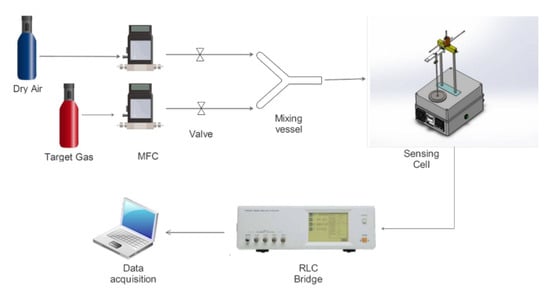
Figure 23.
The gas sensing experimental setup used for micro-sensor measurements, from Ref. [126].
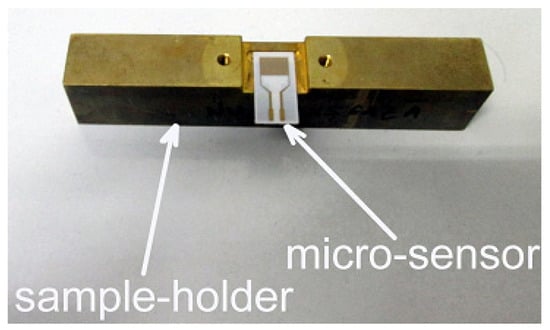
Figure 24.
The sample holder with a micro-sensor in place, from Ref. [126].
The oxide components of the prepared sensitive films were selected, taking into account the promising results obtained from the pellet-type sensitive composites, discussed previously.
The state-of-the-art has evidenced a lot of published work in the gas sensing domain using composite-type sensors [25,26,27,128,129,130,131,132,133]. However, the addition of another oxide component, in the frame of previously published material, usually involves complicated and expensive preparation vapor-based routes (CVD or PVD), ion-beam or laser assisted techniques, spray pyrolysis, the use of dedicated equipment (e.g., screen printing), or multi-stage wet preparation routes that require the use of special templates [74]. A sol-gel/dip coating approach requires low synthesis temperatures (thus less energy consumption) and causes less pollution—being overall an eco-friendly preparation technique.
Using this specific route, a series of SnO2-ZnO sensitive films were synthesized (Table 4). Up to 10 layers of sensitive material were deposited. The sensitive film needed stabilization, therefore a final thermal treatment, consisting in heating the sensor for 1 h at 350 °C, was performed [126,134]. The precursors were: zinc acetate dihydrate (from Merck) and tin(II) 2-ethylhexanoate (from Sigma-Aldrich), which were dissolved in ethanol. As a chelating agent/catalyst, triethanolamine (from Baker Analyzed) was used.

Table 4.
The list of composite SnO2-ZnO based sensors and their composition obtained by sol-gel/dip coating method, after final thermal treatment (350 °C, for 1 h), from Ref. [126].
Sensor response was defined as:
with Rair,gas = electrical resistance of the sensor when exposed to the gas in question (carrier or target gas).
The sensor operating voltage was set at 1.5 V DC. The working temperature was obtained in practice using the heating resistance inserted through the sample holder structure (Figure 24), coupled with a thermocouple and a temperature controller belonging to the sensing cell device, with the purpose of creating a programmed heating ramp to avoid sensor damage from repeated heating-cooling cycles.
The SEM images of the fabricated sensors (Figure 25) evidenced a highly transparent (gold IDE are visible through the film) and uniformly deposited continuous film. Although the sensitive films seem to be highly porous, the nanosized MOX particles are interconnected, so the charge transport mechanism through the oxide film is unaffected [126].
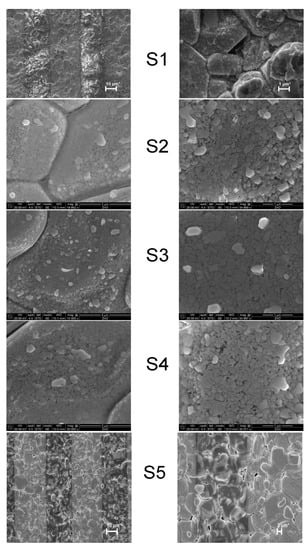
Figure 25.
SEM images of the investigated sensors (S1–S5). Gold interdigits appear as dark grey stripes., from Ref. [126].
Figure 25 shows that the sensors with the highest porosity are the S2 and S4 samples. This promotes gas adsorption and hence the gas sensing process, as more sites for gas adsorption are available for these particular sensors, in comparison with the other prepared sensor samples.
As the gas sensing experiments were recorded, it became obvious that the porosity characteristics noticed using SEM imagery are determining factors for gas sensing performance, as the best gas sensing performance was recorded for the sensors S2 (for CO sensing) and S4 (for relative humidity sensing) in the prepared batch (Figure 26c,d).
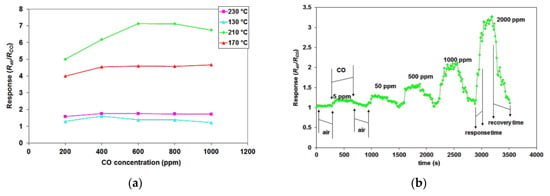
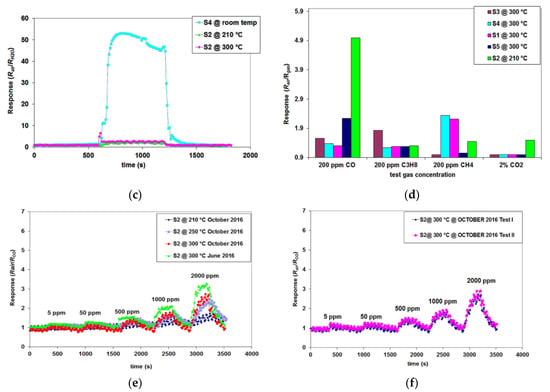
Figure 26.
(a) S2 sensitivity for CO, at specific Tw.; (b) S2 response/recovery characteristic for CO, at Tw = 300 °C; (c) sensor response/recovery characteristics for 62% relative humidity (RH); (d) sensor series cross-sensitivity measurements; (e,f) S2 stability measurements, from Ref. [126].
Sensing measurements performed after one year since sensor preparation showed high sensitivity to low concentrations of CO (5 ppm), with a relatively low Tw (210 °C). A short response (120 s) and a full sensor recovery (280 s) were recorded for CO sensing, with tested concentrations ranging between 5–2000 ppm CO in dry air (Figure 26b). One year later (since the initial tests), the sensor response to CO started to decrease slowly (Figure 26e), and to compensate for this fact, Tw was increased from 210 °C to 300 °C (Figure 26a,b). Sensor S2 response was not influenced by humidity presence, or other target gases (highly selective for CO), as shown by Figure 26c,d. We can conclude that the required high 3S parameters for commercial sensors were partially met for the S2 sensor sample, as the sensitive film is not stable over time. Combined with other key factors, such as small sensor dimensions (size of an office paper clip), the low quantity of deposited sensitive material (up to 0.0035 g according to the authors work from Ref. [135]), a low sensor operating voltage (1.5 V DC), cheap/eco-friendly sensitive film depositing (sol-gel/dip-coating), and commercially available wafer support (alumina from Kyocera), all the circumstances were found favorable for the future development of a new commercial single-gas sensor, which may be used as a fire-detector. Regarding the novelty factor of this study, the state-of-the-art section in the referred article [126] stated that successful gas sensing was achieved when SnO2–ZnO composite metal oxide sensitive films were previously used [25,74,75], but in those cited references, the sensitive films were non-responsive/non-selective for CO, and the sensors were prepared using economically-challenged techniques.
In conclusion, improved sensor response values (3.2) and the sensing protocol involving the use of a DC sensor operating current was achieved by using the transducer concept (ceramic support with included IDEs), but there is still an issue with sensitive film stability over long periods of time (more than 18 months), a clear disadvantage compared to powder- or pellet-type sensors, which are stable in terms of response for several years after preparation. The authors work regarding this kind of micro-sensor prototype was cited by several recently published ISI papers [136,137,138,139,140,141,142,143,144,145,146,147,148,149,150,151,152,153,154].
3.3.3. CoO Thin Film Chemiresistors Used for Selective Detection of CH4
In the next stage, the chemiresistor prototype discussed in the previous section was greatly improved. To this end, a new transducer was designed and constructed, along with a new own-design sensing cell (Figure 27) to accommodate it. More details are provided in the article from reference [155].
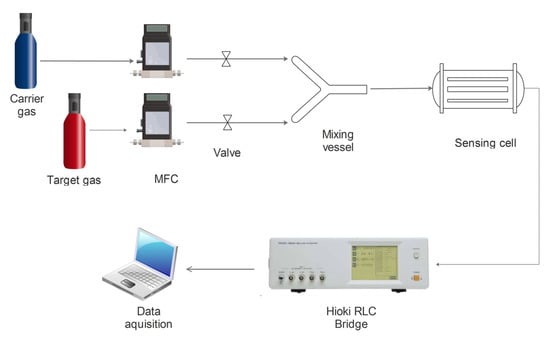
Figure 27.
Schematic representation of the latest gas sensing experimental setup, from Ref. [155].
Sensor miniaturization was applied once more, so a new transducer prototype sized at 5 × 10 × 0.6 mm (Figure 28a,b) was modeled and tested. The new own-design prototype was fabricated by NANOM MEMS SRL in two different versions: with Au or Pt IDEs. The IDEs were imprinted on the alumina wafer using serigraphy-based technology. Given the fact that the alumina wafer was three times thicker than in the previously used prototype, the prepared sensors were subjected to less damage (virtually none) due to user manipulation errors. The IDE design was greatly improved (Figure 28a), having a much higher metallic area compared with the previous prototype (Figure 21).
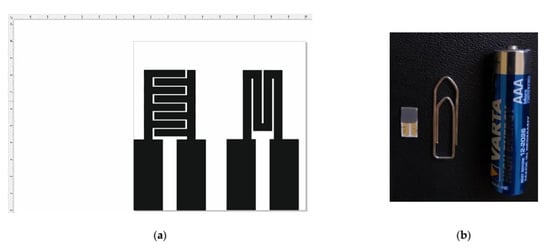
Figure 28.
The new alumina transducer prototype measured at 5 × 10 × 0.6 mm: (a) platinum or gold IDE and platinum heater circuit-schematic representations; (b) actual sensor sample compared with various objects for sizing purposes, from Ref. [155].
On these newly-designed alumina transducers, thin films of CuO and CoO were deposited via a sol-gel/spin coating method, which is considered eco-friendly and also cheap. The precursors were Cu(CO3)2Cu(OH)2 for CuO and Co(CO3)Co(OH)2 for CoO, both commercially available reagents. In Table 5, the prepared samples, their composition, and sample abbreviations are given.

Table 5.
The obtained sensors and their composition, after final thermal treatment (400 °C, for 10 min), from Ref. [155].
From Table 5, it can be observed that there are two main prototype variations: one containing Au IDE (sensor S3) and one containing Pt IDE (sensors S4, S5). These variations were fabricated to check whether or not the IDE material influences the sensor response.
The state-of-the-art section of the Ref. [155], presents previously reported sensing results using CuO and CoO in different combinations as sensitive materials. VOCs, NH3, CO, CO2, H2S [10,156], or CH4 detection (in the percent concentrations range, according to Ref. [157]) was achieved using these oxides as sensing materials, but it involved high-cost fabrication techniques for the sensitive layer (microwave in Ref. [156], thermal oxidation in Ref. [157]). In Ref. [158], the sol-gel approach was used to obtain the sensitive Cu-doped CoO pellets (with silver painted electrodes on each pellet side) used for methane detection, but no humidity/cross-sensitivity sensing assessment were performed, so the sensors were considered as incompletely characterized. As previously discussed, although they are very reliable sensitive materials, large pellet-based sensors imply the usage of large quantities of sensitive material; unless miniaturized devices are modeled (as in the case of TGS-based commercially available sensors), this represents a non-desirable feature from an economical point of view. The working temperature of the sensor was also relatively high (300 °C), which is another important disadvantage due to high energy use.
In our sensing experiments, all sensor measurements were performed under laboratory conditions (dry carrier and target gases). The applied sensor operating voltage was 1.5 V DC, with working temperatures (Tw) ranging between room temperature and 220 °C (specific for each used sensor); the sensing experiments were performed in a continuous gas flow (180 mL/min).
The sensitive films were characterized by SEM as highly porous, including a network of channels on the surface of the sensitive film, which are better evidenced in the case of CoO (Figure 29a).


Figure 29.
SEM images of (a) CoO sensitive film; (b) CuO sensitive film, at different magnification factors; last two images of each group (a,b) are tilted at a specific angle, from Ref. [155].
The sensitive films may be characterized as thin, having sub-micron thickness, but they are no longer transparent, as it can be seen in the actual photo of a sensor sample from Figure 28b (the sensitive film is visible as a dark-grey coating in the IDE area).
As before, the experimental targets were set to obtain high 3S parameters for the tested sensor samples. The sensor’s response for CH4, RH (52%), and CO2 was evaluated and acquired as electrical resistance values (denoted as Rs), directly from the measurement equipment (RLC bridge).
It was observed that the IDE material does not influence gas sensing performance (when comparing gold with platinum, chosen for their superior conductivity characteristics). Out of the sensor prepared series (Figure 30a), it was observed that the cobalt-based sensor is performing better in methane sensing in the higher concentration domain. As in the previous alumina prototype findings (Figure 26a), the Tw was relatively low (210–200 °C), although the thickness of the alumina wafer was three times higher in the present case (0.6 mm compared with 0.2 mm).
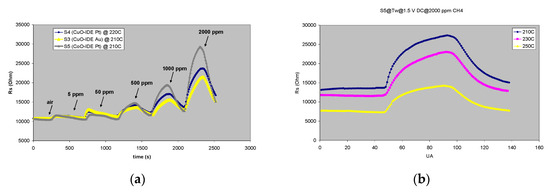
Figure 30.
(a) The response/recovery of the tested sensors for CH4 concentrations in the range of 5–2000 ppm, at Tw specific to the investigated sensors (210–220 °C); (b) response/recovery of the S5 sensor for 2000 ppm CH4 at different Tw, from Ref. [155].
Figure 30a shows an increase in sensor response with increasing target gas concentrations. The sensor’s limit of detection for methane is as low as 5 ppm, but that is imposed by the technical limitations of the experimental setup and not by the sensor capabilities (the target gas is diluted by the carrier gas, from 5000 ppm as provided by the gas manufacturer, to a maximum concentration of 2000 ppm or a minimum of 5 ppm, according to the mass-flow controller calibration curves). The response time of the investigated sensor is fast (250 s), and sensor recovery is complete (250 s), making it possible to resume/repeat the sensing experiments after the sensor recovery stage, without replacing the sensor sample in the sensing cell.
Figure 31 shows the sensors cross-sensitivity for the main target gas (CH4) and the possible interfering species, which may affect sensor response in the investigated environment. The sensor response for each target gas was recorded separately, with air as the carrier gas. It can be seen that all sensors present a higher sensitivity for CH4 (with the S5 response for CH4 almost twice the response measured for the other interfering species). This particular sensor may be considered selective for methane.
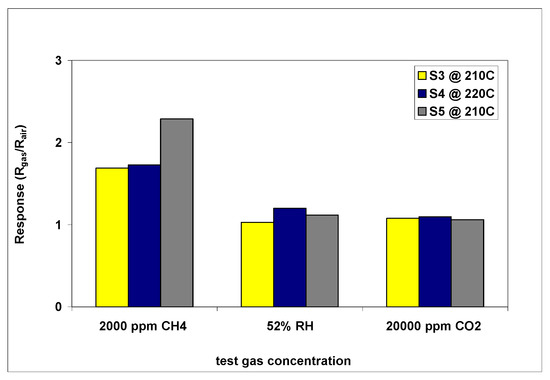
Figure 31.
S3, S4, S5 cross-response for different tested target gas concentrations, from Ref. [155].
The last tested sensor parameter was its stability over a 6 month period (from the initially performed gas-sensing measurements). To this end, S3 was tested repeatedly under identical conditions during a 6 months interval, to check for modifications of the response/recovery characteristics, regarding CH4 detection.
The obtained results are presented in Figure 32.
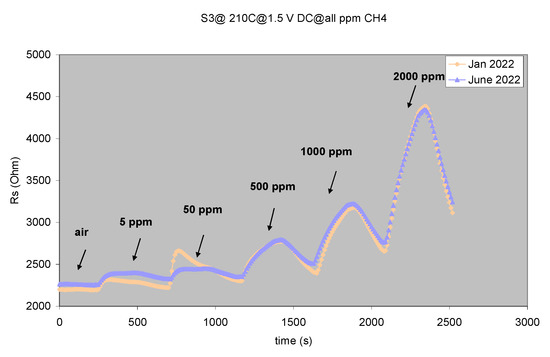
Figure 32.
S3 sensor stability test (6-month period), from Ref. [155].
As seen in Figure 32, the S3 sensor sample is stable for a 6-month period between identical sensing tests, the response to methane being virtually unchanged. Taking into account the results shown by the sensing experiments, we can conclude that the prepared sensor series meet the 3S parameter requirements in order to consider a sensor prototype for further development towards mass-production. The prepared sensor series is characterized by high sensitivity, selectivity (for the S5 sensor sample), and stability, together with other favorable characteristics such as a relatively low working temperature, a short response, and full sensor recovery, the cobalt oxide-based S5 sensor being a very promising candidate for a future portable methane detector, which can be mass-produced.
These favorable sensor parameters were obtained by improving the transducer prototype, which now has a wider IDE area and is more damage-resistant (thicker alumina wafer).
3.4. Real-Life Applications of Chemiresistors
While previous sections were focused on the authors own research and ways to improve well-known raw materials that are used as sensitive materials in chemiresistors, this particular section of the review is dedicated to real-life chemiresistors that are commercially available and which are in use today in various domains. Rapid, comprehensive, and reliable information regarding the chemical state of a gaseous atmosphere is currently required in many technological applications. Chemiresistors are of high interest for many areas, including industry, environmental monitoring, space technology, food industry, automotive, pharmaceutics, etc. [20].
The required features for a detection device to be used in such domains are [20]:
- high sensitivity, selectivity, and stability;
- fast response/recovery characteristics;
- a low power consumption;
- a low operating temperature.
A chemiresistor is presently playing the quantitative and qualitative role in a gas-species detection process, as it must identify the target gas and its concentration in real-life gas mixtures (indoor/outdoor environment, exhaust gases from automobiles, human breath, different smells, etc.). In order to fully perform this task, taking into account that chemiresistors are known to be very sensitive in general but they lack selectivity, more than one sensor must be used. The concept of “e-NOSE” or electronic nose thus emerges for practical applications. In practice an e-nose is represented by a sensor array (a complex system containing a certain number of sensors). Each sensor shows a particular response to all of the target gases (or to a certain subset) which are identified by pattern recognition for the recorded sensor signal [20]. The authors of this review have already submitted a patent for such a device (as co-authors) under code RO20180000598 20180823/RO135084 (A2), currently being processed by the State Office for Inventions and Trademarks (OSIM).
Gardner and Bartlett [20,159] were the first to propose the concept of using multiple semi-selective sensors combined with electronic computation.
Different types of chemiresistors are used in real-life applications, such as: ceramic planary-type sensors, flexible-type plastic sensors, or silicon-based micro-machined sensors. With many applications requiring reduced detection device dimensions (automotive, smartphones and space-tech), nanodevices are currently fabricated, but there is a major issue with the long-term stability of sensor components in these type of devices [20].
As discussed in the previous sections of this review, the sensitive materials used in the fabrication of such detection devices are MOX-based: SnO2, ZnO, TiO, CuO, CoO, and also, in fewer cases, WO3, In2O3, and Fe2O3 may be used [20]. Even in real-life applications, using these oxides as pristine raised the same problems as in the dawn of the sensor era: a lack of selectivity, working temperatures that are too high for practical use, and a general lack of reliability.
As already demonstrated by the authors, some of these problems may be solved in practice by introducing additives (noble metals or a second or third oxide component) or by switching from inorganic sensitive materials to organics or hybrid composites.
According to G. Neri. [20], in the last fifty years of gas sensing, new sensitive materials have been proposed (other than metal oxides) such as conductive polymers (polypyrroles, polythiophenes, polyindoles, and polyanilines), carbon nanostructures (nanotubes, nanorods, nanowires, etc.), and graphene-based materials (a two-dimensional monolayer of carbon atoms), but they all presented a series of issues when used in sensors. Organic materials, which are more versatile in terms of doping modifications are more thermally unstable than inorganic materials, which poses a problem when the working temperature of a sensor increases to the required level, in order to detect a gas species released as a product from a chemical reaction, which takes place on the surface of a sensor. Carbon nanostructures, though very promising in gas sensing applications, are obtainable using very expensive CVD techniques.
As summarized in Table 1, there are many domains in which sensors are used intensively. Such sensors are presented in the following subsections.
3.4.1. Automotive Sensors
The sensors used for automotive-type applications have very distinct features and requirements, such as low dimensions (they must be able to fit in very tight spaces in the engine compartment, or in the exhaust system), the capacity to withstand very high operating temperatures (hot gases from the engine may reach as high as 900 °C), a fast response (seconds), high reliability (years of service), and a low cross-response to interfering species. A high number of different sensors are necessary to monitor various functions inside the automobile: engine performance (air/fuel ratio), emission gases (the functioning of the catalytic system), or the pollutants level inside the vehicle cabin (NO, NO2, CO, CO2, and VOCs) [20,160].
Sensors were introduced in the automotive industry in the late 1970s, when titania-based sensors were used to monitor the air/fuel ration inside the engine [161].
For the proton exchange membrane (PEM) fuel cell systems, used for increased power efficiency, there is a sensor present which measures the CO content of the reformate gas at various catalytic stages [162].
3.4.2. Environmental Sensors
In the frame of environmental applications, MOX chemiresistors are preferred to classic analytical techniques due to lower costs, high portability, reliability, and fast analysis results [163]. With current heavy-pollution problems worldwide, environmental monitoring is a must (event obligatory in some countries), in order to ensure a safe environment for the human population. The most dangerous gases from an environmental point of view are considered to be CO and NO2 [164]. CO2 is another highly toxic gas that needs monitoring, especially in the indoor environment [165]; therefore, the quest for specialized sensors which measure CO2 levels in breathable atmosphere has always been of high priority in the gas-sensing domain. According to Fine et al. [164], many different fabrication routes have been developed for the production of MOX-based sensors. Factors to be taken into account when selecting a particular production technique include costs (if the films are expensive, the demand for those sensors will be low and they will have only limited applications), purity, porosity (a highly porous material means a higher surface area available for interaction with the target gas, leading to higher sensitivity), reliability, and reproducibility. Widely used fabrication techniques for MOX-based sensitive films are considered, including vapor techniques such as CVD or PVD, screen-printing of ceramic powders, and sol-gel techniques. Comparing the synthesis methods involved in the sensor fabrication, the cited article [164] reads:
- “PVD is an expensive and time consuming method, due to the high vacuum conditions and evaporation/sputtering equipment, therefore economic factors restrict the commercial applications for sensors obtained in such way;
- CVD produces dense films which is a disadvantage for gas sensors as the contribution from the bulk resistance is substantially increased;
- Sol-gel methods are straightforward to operate, but the time required to establish the sol is important for obtaining the desired product, thus can be a slow multi-step process. Full coverage of the substrate with moderately even thickness can be achieved, by using readily available precursors, although these are often expensive. Dopants may be easily introduced and the sol-gel process has low processing temperatures;
- Screen-printing is an industry standard technique. Thick films leads to much more reliable sensor devices than thin film types. Thin film devices are often more sensitive, although not necessarily more selective, but suffer from high baseline resistance due to a lower overall number of charge carriers whether in the bulk or on the surface of the material”.
3.4.3. Medical Sensors
The chemiresistors used in biomedical applications must have extremely high sensitivity, as they must identify gases (markers for different pathologies [20]) with concentrations in the ppt range. The recognition process must also be selective and non-influenced by the high humidity environment from the human body [166,167,168].
According to Refs. [167,168], the so-called breath markers (certain VOCs present in the breath) correlate to specific diseases. Acetone, one of the most abundant components in the breath, was studied in detail and related to specific metabolic disorders. When ammonia is present at relatively high concentrations in the human breath (~830 ppb) it is a sign of: bacterial multiplication in the oral cavity, kidney disease, infection with Helicobacter pylori, or hepatic encephalopathy. Pulmonary diseases, such as asthma, are identified using breath markers, such as exhaled CO and nitric oxide (NO). Cirrhotic patients may be identified using the characteristic odor in the breath given by sulfur-containing compounds, such as dimethylsulfide. Being a non-invasive technique, breath analysis has become increasingly significant for applications in clinical diagnostics using gas sensors. It is also highly-preferable over other investigative methods in the medical field (blood sample investigations) due to the reduced trauma effect, especially in the case of diabetic patients who have to give blood samples up to three times per day [167].
3.5. Latest Concepts and Developments in Gas Sensor Design
Although chemiresistors are the most used gas detection devices currently used, due to their small dimensions, high-availability, low cost, and good overall sensing performance, there is a constant need for novel, miniaturized, high-performance sensors for dedicated advanced applications.
New sensing materials, supports, and assembly techniques into the final device are currently developed for this purpose. For example a thin plastic-stripe sensor is woven into a cotton fabric by using a standard weaving machine, in order to create a smart fabric that can detect ambient gas. Microelectronics technology is involved in manufacturing both the sensing element and the signal processing circuits in the frame of a single silicon chip, to create low-cost smart gas sensors with low-power requirements, spawning a new generation of miniaturized mass-produced gas sensors [20,169]. Commercially available MEMS (micro electronics mechanical systems on a single wafer) were introduced by Figaro Eng. Inc., which used silicon processing technology [170]. Such sensors may be used as indoor/outdoor air quality monitors.
Chemosensors are now integrated into smartphones, tablets, and other portable monitoring devices, that may even be accessed by remote WiFi connections by the potential users, who may be alerted instantly of possible dangerous situations, such as gas leaks or fires in their homes which require immediate action for the safety of the community, even if they are not physically present at that certain location. This is a situation that was not even imaginable a few decades ago.
As mentioned before in this review, the use of commercially-available gas sensors usually involves a compromise between the user needs and the economic aspects of the chosen solution.
4. Conclusions
This review is based on the authors previously published papers, which cover the main types of MOX-based sensitive materials (powders, pellets, films).
To keep up with modern sensor requirements, these types of materials were functionally improved and constantly miniaturized, quantity usage- and device dimensions-wise, always having as a reference the required high 3S parameters (sensitivity, selectivity and stability) needed in order to transform a working sensor prototype into a commercially viable sensor. As presented in this review, each type of sensitive material has its advantages and disadvantages, so a compromise must be made between sensor parameters, the cost of production and the ability to fabricate these sensors on a wide scale (implies abundant raw materials). For example powder-type sensitive materials are the most stable and reliable during time, having a lifetime of many years after preparation; they provide highly precise and intense sensor response to tested target gases, but the use of powders in a sensing device may involve usage of a high quantity of precursors (unless the sensing device is highly miniaturized, as in the real-life TGS-based sensors); pellet-type materials have the advantage of a smaller occupied volume than powders, excellent sensitivity, stability, and even high selectivity (when composite materials are used), but still large quantities of reagents may be used in the preparation stage. These two types of sensitive materials may be used in industrial applications, such as fuel cells, where high working temperatures are involved and highly reliable materials must be used in the fabrication of the sensing device. On the other hand, the sensitive films used by the authors are more easily prepared, with lower costs and greener methods, but in certain sensor configurations, they may be unstable over time. Additionally, for improved conductivity reasons and thus superior sensor response, a metal electrode must be present on the sensor support to facilitate the charge transfer between the sensitive film and the measuring equipment. These disadvantages may be overcome when using a specific transducer design (with wider IDEs) and denser sensitive films for improved sensor stability.
Once these key factors are balanced, as demonstrated in this review, promising candidates may emerge for future mass-produced chemiresistors, and some of the problems encountered even in the present day (false alarms, sensor poor reliability, or low-selectivity) could be eliminated using the practical solutions suggested by the authors of this review.
Author Contributions
Conceptualization, P.C. and C.H.; methodology, P.C. and C.H.; software, P.C. and C.H.; validation, P.C. and C.H.; formal analysis, P.C. and C.H.; investigation, P.C. and C.H.; resources, P.C. and C.H.; data curation, P.C.; writing—original draft preparation, P.C.; writing—review and editing, P.C.; visualization, P.C.; supervision, P.C. All authors have read and agreed to the published version of the manuscript.
Funding
This research was funded by: the support of the EU (ERDF) and Romanian Government that allowed for acquisition of the research infrastructure under POS-CCE O 2.2.1 project INFRANANOCHEM-Nr. 19/01.03.2009; the European Social Fund within the TA’MOP-4.2.2.B-15/1/KONV-2015-0004 project; the Romanian PN II-PT-PCCA13/2014 project; and the Romanian National Authority for Scientific Research on Innovation, CCCDI-UEFISCDI, grant number “PN-III-P2-2.1-PED-2019-2073, Contract 308PED/2020”. The APC was funded by MDPI.
Institutional Review Board Statement
Not applicable.
Informed Consent Statement
Not applicable.
Data Availability Statement
The datasets generated during and/or analyzed during the current study are available from the corresponding author on reasonable request.
Acknowledgments
The contributions of: Cornel Munteanu, Veronica Bratan, Niculae I. Ionescu, Georgeta Postole, Cristian Iacob, Florin Svet, Tania Yuzhakova, Akos Redey, Susana Mihaiu, Cristina Vladut, Jose Maria Calderon-Moreno, Mihai Anastasescu, Maria Zaharescu, Izabella Dascalu, Mariana Chelu, Costin Brasoveanu, Bogdan Firtat, George Muscalu, Carmen Moldovan, Ion Stan, Vlad Georgescu, Marin Gheorghe, and Mariuca Gartner are greatly acknowledged.
Conflicts of Interest
The authors declare no conflict of interest. The funders had no role in the design of the study; in the collection, analyses, or interpretation of data; in the writing of the manuscript; or in the decision to publish the results.
References
- Atmosphere of Earth. Available online: https://en.wikipedia.org/wiki/Atmosphere_of_Earth (accessed on 23 December 2022).
- CO Health Risks. Available online: https://www.detectcarbonmonoxide.com/co-health-risks (accessed on 23 December 2022).
- Fraden, J. Handbook of Modern Sensors; Springer: Berlin/Heidelberg, Germany, 2010; ISBN 978-1-4419-6465-6. [Google Scholar]
- Kappler, J.T. Characterisation of High-Performance SnO2 Gas Sensors for CO Detection by In Situ Techniques; Shaker: Düren, Germany, 2001; ISBN 3826590406. [Google Scholar]
- Ripka, P.; Tipek, A. Modern Sensors Handbook; John Wiley & Sons: Hoboken, NJ, USA, 2013; ISBN 111861478X. [Google Scholar]
- Shirke, A.G. Sub-Femtomolar Isothermal Desorption and Reaction Kinetics on Microhotplate Sensor Platforms. Ph.D. Dissertation, The University of Maine, Orono, ME, USA, 2007. [Google Scholar]
- Lipert, R.J.; Shinar, R.; Vaidya, B.; Pris, A.D.; Porter, M.D.; Liu, G.; Grabau, T.D.; Dilger, J.P. Thin Films of Block Copolymer Blends for Enhanced Performance of Acoustic Wave-Based Chemical Sensors. Anal. Chem. 2002, 74, 6383–6391. [Google Scholar] [CrossRef] [PubMed]
- Chesler, P.; Vladut, A. Senzori Chimici Rezistivi; Editura Berg: Sălaj, Romania, 2020; ISBN 978-606-9036-60-0. CIP 2020-14467. [Google Scholar]
- Chesler, P. Oxizi cu Proprietăţi de Senzori de Gaze. Doctoral Dissertation, Institutul de Chimie Fizică Ilie Murgulescu, Bucureşti, Romania, 2017. [Google Scholar] [CrossRef]
- Rydosz, A. The Use of Copper Oxide Thin Films in Gas-Sensing Applications. Coatings 2018, 8, 425. [Google Scholar] [CrossRef]
- Wagner, C.; Hauffe, K. The Stationary State of Catalysts in Homogeneous Reactions. Ztschr. Elektrochem. 1938, 33, 172. [Google Scholar]
- Ciureanu, P.; Middelhoek, S. Thin Film Resistive Sensors; CRC Press: Boca Raton, FL, USA, 1992; ISBN 0750301732. [Google Scholar]
- Brattain, W.H.; Bardeen, J. Surface Properties of Germanium. Bell Syst. Tech. J. 1953, 32, 1–41. [Google Scholar] [CrossRef]
- Heiland, G. Zum Einfluß von Adsorbiertem Sauerstoff Auf Die Elektrische Leitfähigkeit von Zinkoxydkristallen. Zeitschrift Phys. 1954, 138, 459–464. [Google Scholar] [CrossRef]
- Morrison, S.R. Surface Barrier Effects in Adsorption, Illustrated by Zinc Oxide. In Advances in Catalysis; Elsevier: Amsterdam, The Netherlands, 1955; Volume 7, pp. 259–301. ISBN 0360-0564. [Google Scholar]
- Seiyama, T.; Kato, A.; Fujiishi, K.; Nagatani, M. A New Detector for Gaseous Components Using Semiconductive Thin Films. Anal. Chem. 1962, 34, 1502–1503. [Google Scholar] [CrossRef]
- Shaver, P.J. Activated Tungsten Oxide Gas Detectors. Appl. Phys. Lett. 1967, 11, 255–257. [Google Scholar] [CrossRef]
- Taguchi, N. Method for Making a Gas-Sensing Element. U.S. Patent No. 3,625,756, 07 December 1971. [Google Scholar]
- Madou, M.J.; Morrison, S.R. Chemical Sensing with Solid State Devices; Elsevier: Amsterdam, The Netherlands, 2012; ISBN 032313985X. [Google Scholar]
- Neri, G. First Fifty Years of Chemoresistive Gas Sensors. Chemosensors 2015, 3, 1–20. [Google Scholar] [CrossRef]
- TGS 813 Figaro. Available online: https://www.soselectronic.ro/products/figaro/tgs-813-483 (accessed on 23 December 2022).
- TGS 826-A00 Figaro. Available online: https://www.soselectronic.ro/products/figaro/tgs-826-a00-53106 (accessed on 23 December 2022).
- Eranna, G.; Joshi, B.C.; Runthala, D.P.; Gupta, R.P. Oxide Materials for Development of Integrated Gas Sensors—A Comprehensive Review. Crit. Rev. Solid State Mater. Sci. 2004, 29, 111–188. [Google Scholar] [CrossRef]
- Barsan, N.; Weimar, U. Conduction Model of Metal Oxide Gas Sensors. J. Electroceramics 2001, 7, 143–167. [Google Scholar] [CrossRef]
- Mondal, B.; Basumatari, B.; Das, J.; Roychaudhury, C.; Saha, H.; Mukherjee, N. ZnO–SnO2 Based Composite Type Gas Sensor for Selective Hydrogen Sensing. Sens. Actuators B Chem. 2014, 194, 389–396. [Google Scholar] [CrossRef]
- Kim, H.-J.; Lee, J.-H. Highly Sensitive and Selective Gas Sensors Using p-Type Oxide Semiconductors: Overview. Sens. Actuators B Chem. 2014, 192, 607–627. [Google Scholar] [CrossRef]
- Šutka, A.; Gross, K.A. Spinel Ferrite Oxide Semiconductor Gas Sensors. Sens. Actuators B Chem. 2016, 222, 95–105. [Google Scholar] [CrossRef]
- Comini, E.; Faglia, G.; Sberveglieri, G.; Li, Y.X.; Wlodarski, W.; Ghantasala, M.K. Sensitivity Enhancement towards Ethanol and Methanol of TiO2 Films Doped with Pt and Nb. Sens. Actuators B Chem. 2000, 64, 169–174. [Google Scholar] [CrossRef]
- Caldararu, M.; Munteanu, C.; Chesler, P.; Carata, M.; Hornoiu, C.; Ionescu, N.I.; Postole, G.; Bratan, V. Supported Oxides as Combustion Catalysts and as Humidity Sensors. Tuning the Surface Behavior by Inter-Phase Charge Transfer. Microporous Mesoporous Mater. 2007, 99, 126–131. [Google Scholar] [CrossRef]
- Caldararu, M.; Scurtu, M.; Hornoiu, C.; Munteanu, C.; Blasco, T.; López Nieto, J.M. Electrical Conductivity of a MoVTeNbO Catalyst in Propene Oxidation Measured in Operando Conditions. Catal. Today 2010, 155, 311–318. [Google Scholar] [CrossRef]
- Chesler, P.; Hornoiu, C.; Bratan, V.; Munteanu, C.; Gartner, M.; Ionescu, N.I. Carbon Monoxide Sensing Properties of TiO2. Rev. Roum. Chim. 2015, 60, 227–232. [Google Scholar]
- Prockop, L.D.; Chichkova, R.I. Carbon Monoxide Intoxication: An Updated Review. J. Neurol. Sci. 2007, 262, 122–130. [Google Scholar] [CrossRef]
- Cobb, N.; Ra, E. UNintentional Carbon Monoxide—Related Deaths in the United States, 1979 through 1988. JAMA 1991, 266, 659–663. [Google Scholar] [CrossRef]
- Runyan, C.W.; Johnson, R.M.; Yang, J.; Waller, A.E.; Perkis, D.; Marshall, S.W.; Coyne-Beasley, T.; McGee, K.S. Risk and Protective Factors for Fires, Burns, and Carbon Monoxide Poisoning in US Households. Am. J. Prev. Med. 2005, 28, 102–108. [Google Scholar] [CrossRef]
- Varon, J.; Marik, P.E.; Fromm, R.E., Jr.; Gueler, A. Carbon Monoxide Poisoning: A Review for Clinicians. J. Emerg. Med. 1999, 17, 87–93. [Google Scholar] [CrossRef] [PubMed]
- Dutta, P.K.; Ginwalla, A.; Hogg, B.; Patton, B.R.; Chwieroth, B.; Liang, Z.; Gouma, P.; Mills, M.; Akbar, S. Interaction of Carbon Monoxide with Anatase Surfaces at High Temperatures: Optimization of a Carbon Monoxide Sensor. J. Phys. Chem. B 1999, 103, 4412–4422. [Google Scholar] [CrossRef]
- Bratan, V.; Chesler, P.; Hornoiu, C.; Scurtu, M.; Postole, G.; Pietrzyk, P.; Gervasini, A.; Auroux, A.; Ionescu, N.I. In Situ Electrical Conductivity Study of Pt-Impregnated VOx/Gamma-Al2O3 Catalysts in Propene Deep Oxidation. J. Mater. Sci. 2020, 55, 10466–10481. [Google Scholar] [CrossRef]
- Budiman, H.; Wibowo, R.; Zuas, O.; Gunlazuardi, J. Effect of Annealing Temperature on the Characteristic of Reduced Highly Ordered TiO2 nanotube Arrays and Their CO Gas-Sensing Performance. Process. Appl. Ceram. 2021, 15, 417–427. [Google Scholar] [CrossRef]
- Vasile, A.; Bratan, V.; Hornoiu, C.; Caldararu, M.; Ionescu, N.I.; Yuzhakova, T.; Rédey, Á. Electrical and Catalytic Properties of Cerium–Tin Mixed Oxides in CO Depollution Reaction. Appl. Catal. B Environ. 2013, 140–141, 25–31. [Google Scholar] [CrossRef]
- Chesler, P.; Hornoiu, C.; Bratan, V.; Munteanu, C.; Postole, G.; Ionescu, N.I.; Juzsakova, T.; Redey, A.; Gartner, M. CO Sensing Properties of SnO2–CeO2 Mixed Oxides. React. Kinet. Mech. Catal. 2016, 117, 551–563. [Google Scholar] [CrossRef]
- Harrison, P.G.; Ball, I.K.; Azelee, W.; Daniell, W.; Goldfarb, D. Nature and Surface Redox Properties of Copper(II)-Promoted Cerium(IV) Oxide CO-Oxidation Catalysts. Chem. Mater. 2000, 12, 3715–3725. [Google Scholar] [CrossRef]
- Stošić, D.; Bennici, S.; Rakić, V.; Auroux, A. CeO2–Nb2O5 Mixed Oxide Catalysts: Preparation, Characterization and Catalytic Activity in Fructose Dehydration Reaction. Catal. Today 2012, 192, 160–168. [Google Scholar] [CrossRef]
- Yuzhakova, T.; Rakić, V.; Guimon, C.; Auroux, A. Preparation and Characterization of Me2O3−CeO2 (Me = B, Al, Ga, In) Mixed-Oxide Catalysts. Chem. Mater. 2007, 19, 2970–2981. [Google Scholar] [CrossRef]
- Vasile, A.; Caldararu, M.; Hornoiu, C.; Bratan, V.; Ionescul, N.I.; Yuzhakova, T.; Redey, A. Elimination of Gas Pollutants Using SnO2-CeO2 Catalysts. Environ. Eng. Manag. J. 2012, 11, 481–486. [Google Scholar] [CrossRef]
- Yuzhakova, T.; Rédey, Á.; Vasile, A.; Hornoiu, C.; Bratan, V.; Utasi, A.; Kovacs, J. Thermal Stability and Surface Structure of SnO2-CeO2 Impregnated Catalysts. Environ. Eng. Manag. J. 2012, 11, 225–230. [Google Scholar] [CrossRef]
- Durrani, S.M.A.; Al-Kuhaili, M.F.; Bakhtiari, I.A. Carbon Monoxide Gas-Sensing Properties of Electron-Beam Deposited Cerium Oxide Thin Films. Sens. Actuators B Chem. 2008, 134, 934–939. [Google Scholar] [CrossRef]
- Royer, S.; Duprez, D. Catalytic Oxidation of Carbon Monoxide over Transition Metal Oxides. ChemCatChem. 2011, 3, 24–65. [Google Scholar] [CrossRef]
- Barreca, D.; Gasparotto, A.; Maccato, C.; Maragno, C.; Tondello, E.; Comini, E.; Sberveglieri, G. Columnar CeO2 Nanostructures for Sensor Application. Nanotechnology 2007, 18, 125502. [Google Scholar] [CrossRef]
- Khawaja, E.E.; Durrani, S.M.A.; Al-Kuhaili, M.F. Determination of Average Refractive Index of Thin CeO2 Films with Large Inhomogeneities. J. Phys. D Appl. Phys. 2003, 36, 545. [Google Scholar] [CrossRef]
- Izu, N.; Shin, W.; Murayama, N.; Kanzaki, S. Resistive Oxygen Gas Sensors Based on CeO2 Fine Powder Prepared Using Mist Pyrolysis. Sensors Actuators B Chem. 2002, 87, 95–98. [Google Scholar] [CrossRef]
- Trovarelli, A. Catalytic Properties of Ceria and CeO2-Containing Materials. Catal. Rev. 1996, 38, 439–520. [Google Scholar] [CrossRef]
- Beie, H.-J.; Gnörich, A. Oxygen Gas Sensors Based on CeO2 Thick and Thin Films. Sens. Actuators B Chem. 1991, 4, 393–399. [Google Scholar] [CrossRef]
- Sharma, R.K.; Chan, P.C.H.; Tang, Z.; Yan, G.; Hsing, I.-M.; Sin, J.K.O. Sensitive, Selective and Stable Tin Dioxide Thin-Films for Carbon Monoxide and Hydrogen Sensing in Integrated Gas Sensor Array Applications. Sens. Actuators B Chem. 2001, 72, 160–166. [Google Scholar] [CrossRef]
- Mandayo, G.G.; Castaño, E.; Gracia, F.J.; Cirera, A.; Cornet, A.; Morante, J.R. Strategies to Enhance the Carbon Monoxide Sensitivity of Tin Oxide Thin Films. Sens. Actuators B Chem. 2003, 95, 90–96. [Google Scholar] [CrossRef]
- Park, S.-S.; Mackenzie, J.D. Thickness and Microstructure Effects on Alcohol Sensing of Tin Oxide Thin Films. Thin Solid Films 1996, 274, 154–159. [Google Scholar] [CrossRef]
- Fang, G.; Liu, Z.; Liu, C.; Yao, K. Room Temperature H2S Sensing Properties and Mechanism of CeO2–SnO2 Sol–Gel Thin Films. Sens. Actuators B Chem. 2000, 66, 46–48. [Google Scholar] [CrossRef]
- Figaj, M.; Becker, K.D. An Electron Paramagnetic Resonance Study of Impurities in Ceria, CeO2. Solid State Ion. 2001, 141–142, 507–512. [Google Scholar] [CrossRef]
- Taylor, K.C. Nitric Oxide Catalysis in Automotive Exhaust Systems. Catal. Rev. Eng. 1993, 35, 457–481. [Google Scholar] [CrossRef]
- Yuzhakova, T.; Caldararu, M.; Kovács, J.; Postole, G.; Hornoiu, C.; Vasile, A.; Domokos, E. SnO2-CeO2 Oxidation Catalysts. Environ. Eng. Manag. J. 2009, 8, 1403–1406. [Google Scholar] [CrossRef]
- Munteanu, C.; Caldararu, M.; Bratan, V.; Yetisemiyen, P.; Karakas, G.; Ionescu, N.I. Electrical and Catalytic Properties of SnO2/TiO2 Measured in Operando Conditions. React. Kinet. Mech. Catal. 2012, 105, 13–22. [Google Scholar] [CrossRef]
- Dascalu, I.; Culita, D.; Calderon-Moreno, J.M.; Osiceanu, P.; Hornoiu, C.; Anastasescu, M.; Somacescu, S.; Gartner, M. Structural, Textural, Surface Chemistry and Sensing Properties of Mesoporous Pr, Zn Modified SnO2–TiO2 Powder Composites. Ceram. Int. 2016, 42, 14992–14998. [Google Scholar] [CrossRef]
- Wang, J.; Li, Z.; Zhang, S.; Yan, S.; Cao, B.; Wang, Z.; Fu, Y. Enhanced NH3 Gas-Sensing Performance of Silica Modified CeO2 Nanostructure Based Sensors. Sens. Actuators B Chem. 2018, 255, 862–870. [Google Scholar] [CrossRef]
- Gu, C.; Qi, R.; Wei, Y.; Zhang, X. Preparation and Performances of Nanorod-like Inverse CeO2-CuO Catalysts Derived from Ce-1,3,5-Benzene Tricarboxylic Acid for CO Preferential Oxidation. React. Kinet. Mech. Catal. 2018, 124, 651–667. [Google Scholar] [CrossRef]
- Zhao, R.; Tang, D.; Wu, Q.; Li, W.; Zhang, X.; Guo, R.; Chen, M.; Diao, G. Double-Shell SnO2/CeO2: Yb, Er Hollow Nanospheres as an Assistant Layer That Suppresses Charge Recombination in Dye-Sensitized Solar Cells. New J. Chem. 2018, 42, 14453–14458. [Google Scholar] [CrossRef]
- Khodadadi, A.; Mohajerzadeh, S.S.; Mortazavi, Y.; Miri, A.M. Cerium Oxide/SnO2-Based Semiconductor Gas Sensors with Improved Sensitivity to CO. Sens. Actuators B Chem. 2001, 80, 267–271. [Google Scholar] [CrossRef]
- Vendrell, X.; Kubyshin, Y.; Mestres, L.; Llorca, J. CO Oxidation on Ceria Studied by Electrochemical Impedance Spectroscopy. ChemCatChem 2020, 12, 59265931. [Google Scholar] [CrossRef]
- Leangtanom, P.; Wisitsoraat, A.; Jaruwongrungsee, K.; Chanlek, N.; Phanichphant, S.; Kruefu, V. Highly Sensitive and Selective Ethylene Gas Sensors Based on CeOx-SnO2 Nanocomposites Prepared by a Co-Precipitation Method. Mater. Chem. Phys. 2020, 254, 123540. [Google Scholar] [CrossRef]
- Bi, H.; Zhang, L.X.; Xing, Y.; Zhang, P.; Chen, J.J.; Yin, J.; Bie, L.J. Morphology-Controlled Synthesis of CeO2 Nanocrystals and Their Facet-Dependent Gas Sensing Properties. Sens. Actuators B Chem. 2021, 330, 129374. [Google Scholar] [CrossRef]
- Chesler, P.; Hornoiu, C.; Mihaiu, S.; Munteanu, C.; Gartner, M. Tin–Zinc Oxide Composite Ceramics for Selective CO Sensing. Ceram. Int. 2016, 42, 16677–16684. [Google Scholar] [CrossRef]
- Lee, D.-D.; Sohn, B.-K.; Ma, D.-S. Low Power Thick Film CO Gas Sensors. Sens. Actuators 1987, 12, 441–447. [Google Scholar] [CrossRef]
- Li, G.-J.; Zhang, X.-H.; Kawi, S. Relationships between Sensitivity, Catalytic Activity, and Surface Areas of SnO2 Gas Sensors. Sens. Actuators B Chem. 1999, 60, 64–70. [Google Scholar] [CrossRef]
- NIOSH. NIOSH Recommendations for Occupational Safety and Health; US Department of Health and Human Services, Public Health Service Centers: Washington, DC, USA, 1992.
- Yu, J.H.; Choi, G.M. Electrical and CO Gas Sensing Properties of ZnO–SnO2 Composites. Sens. Actuators B Chem. 1998, 52, 251–256. [Google Scholar]
- Hemmati, S.; Anaraki Firooz, A.; Khodadadi, A.A.; Mortazavi, Y. Nanostructured SnO2–ZnO Sensors: Highly Sensitive and Selective to Ethanol. Sens. Actuators B Chem. 2011, 160, 1298–1303. [Google Scholar] [CrossRef]
- De Lacy Costello, B.P.J.; Ewen, R.J.; Jones, P.R.H.; Ratcliffe, N.M.; Wat, R.K.M. Study of the Catalytic and Vapour-Sensing Properties of Zinc Oxide and Tin Dioxide in Relation to 1-Butanol and Dimethyldisulphide. Sens. Actuators B Chem. 1999, 61, 199–207. [Google Scholar] [CrossRef]
- Sonker, R.K.; Sharma, A.; Shahabuddin, M.; Tomar, M.; Gupta, V. Low Temperature Sensing of NO2 Gas Using SnO2-ZnO Nanocomposite Sensor. Adv. Mat. Lett 2013, 4, 196–201. [Google Scholar]
- Nanto, H.; Morita, T.; Habara, H.; Kondo, K.; Douguchi, Y.; Minami, T. Doping Effect of SnO2 on Gas Sensing Characteristics of Sputtered ZnO Thin Film Chemical Sensor. Sens. Actuators B Chem. 1996, 36, 384–387. [Google Scholar] [CrossRef]
- Raju, A.R.; Rao, C.N.R. Gas-Sensing Characteristics of ZnO and Copper-Impregnated ZnO. Sens. Actuators B Chem. 1991, 3, 305–310. [Google Scholar] [CrossRef]
- Yu, J.H.; Choi, G.M. Electrical and CO Gas-Sensing Properties of ZnO/SnO2 Hetero-Contact. Sens. Actuators B Chem. 1999, 61, 59–67. [Google Scholar] [CrossRef]
- Egashira, M.; Shimizu, Y.; Takao, Y.; Sako, S. Variations in I–V Characteristics of Oxide Semiconductors Induced by Oxidizing Gases. Sens. Actuators B Chem. 1996, 35, 62–67. [Google Scholar] [CrossRef]
- Yoon, D.H.; Yu, J.H.; Choi, G.M. CO Gas Sensing Properties of ZnO–CuO Composite. Sens. Actuators B Chem. 1998, 46, 15–23. [Google Scholar] [CrossRef]
- Mao, W.; Li, Z.; Bao, K.; Zhang, K.; Wang, W.; Li, B. Nanowire-Based Zinc-Doped Tin Oxide Microtubes for Enhanced Solar Energy Utilization Efficiency. Ceram. Int. 2017, 43, 6822–6830. [Google Scholar] [CrossRef]
- Dascalu, I.; Somacescu, S.; Hornoiu, C.; Calderon-Moreno, J.M.; Stanica, N.; Stroescu, H.; Anastasescu, M.; Gartner, M. Sol-Gel Zn, Fe Modified SnO2 Powders for CO Sensors and Magnetic Applications. Process Saf. Environ. Prot. 2018, 117, 722–729. [Google Scholar] [CrossRef]
- Wang, T.; Li, Y.; Li, T.; Yu, H.; Yang, Y.; Yang, H.; Dong, X. Enhanced NOx Gas Sensing Properties of Cr2O3 Film Modified Ordered Porous ZnO Gas Sensors. Solid State Ion. 2018, 326, 173–182. [Google Scholar] [CrossRef]
- Jiang, R.; Jia, L.; Guo, X.; Zhao, Z.; Du, J.; Wang, X.; Wang, P.; Xing, F. Dimethyl Sulfoxide-Assisted Hydrothermal Synthesis of Co3O4-Based Nanorods for Selective and Sensitive Diethyl Ether Sensing. Sens. Actuators B Chem. 2019, 290, 275–284. [Google Scholar] [CrossRef]
- Jutimoosik, J.; Jantaratana, P.; Yimnirun, R.; Prasatkhetragarn, A. Phase Formation, Morphology and Magnetic Properties of PbTiO3-Fe2O3 Heterostructure Ceramics. Integr. Ferroelectr. 2021, 214, 19–26. [Google Scholar] [CrossRef]
- Zhou, L.; Yu, S.; Yang, Y.; Li, Q.; Li, T.; Zhang, D. Adsorption of Gas Molecules (NH3, C2H6O, C3H6O, CO, H2S) on a Noble Metal (Ag, Au, Pt, Pd, Ru)-Doped MoSe2 Monolayer: A First-Principles Study. New J. Chem. 2021, 45, 12367–12376. [Google Scholar] [CrossRef]
- Huang, C.X.; Chen, G.R.; Nashalian, A.; Chen, J. Advances in Self-Powered Chemical Sensing via a Triboelectric Nanogenerator. Nanoscale 2021, 13, 2065–2081. [Google Scholar] [CrossRef]
- Duta, M.; Predoana, L.; Calderon-Moreno, J.M.; Preda, S.; Anastasescu, M.; Marin, A.; Dascalu, I.; Chesler, P.; Hornoiu, C.; Zaharescu, M.; et al. Nb-Doped TiO2 Sol–Gel Films for CO Sensing Applications. Mater. Sci. Semicond. Process. 2016, 42, 397–404. [Google Scholar] [CrossRef]
- Moon, H.G.; Jang, H.W.; Kim, J.-S.; Park, H.-H.; Yoon, S.-J. Size Effects in the CO Sensing Properties of Nanostructured TiO2 Thin Films Fabricated by Colloidal Templating. Electron. Mater. Lett. 2010, 6, 31–34. [Google Scholar] [CrossRef]
- Seo, M.-H.; Yuasa, M.; Kida, T.; Huh, J.-S.; Shimanoe, K.; Yamazoe, N. Gas Sensing Characteristics and Porosity Control of Nanostructured Films Composed of TiO2 Nanotubes. Sens. Actuators B Chem. 2009, 137, 513–520. [Google Scholar] [CrossRef]
- Li, Z.; Ding, D.; Liu, Q.; Ning, C.; Wang, X. Ni-Doped TiO2 Nanotubes for Wide-Range Hydrogen Sensing. Nanoscale Res. Lett. 2014, 9, 118. [Google Scholar] [CrossRef]
- Ferroni, M.; Carotta, M.C.; Guidi, V.; Martinelli, G.; Ronconi, F.; Richard, O.; Van Dyck, D.; Van Landuyt, J. Structural Characterization of Nb–TiO2 Nanosized Thick-Films for Gas Sensing Application. Sens. Actuators B Chem. 2000, 68, 140–145. [Google Scholar] [CrossRef]
- Furubayashi, Y.; Hitosugi, T.; Yamamoto, Y.; Inaba, K.; Kinoda, G.; Hirose, Y.; Shimada, T.; Hasegawa, T. A Transparent Metal: Nb-Doped Anatase TiO2. Appl. Phys. Lett. 2005, 86, 2101. [Google Scholar] [CrossRef]
- Zeng, W.; Liu, T.; Wang, Z. Impact of Nb Doping on Gas-Sensing Performance of TiO2 Thick-Film Sensors. Sens. Actuators B Chem. 2012, 166–167, 141–149. [Google Scholar] [CrossRef]
- Anukunprasert, T.; Saiwan, C.; Traversa, E. The Development of Gas Sensor for Carbon Monoxide Monitoring Using Nanostructure of Nb–TiO2. Sci. Technol. Adv. Mater. 2005, 6, 359–363. [Google Scholar] [CrossRef]
- Ruiz, A.; Calleja, A.; Espiell, F.; Cornet, A.; Morante, J.R. Nanosized Nb-TiO2 Gas Sensors Derived from Alkoxides Hydrolization. IEEE Sens. J. 2003, 3, 189–194. [Google Scholar] [CrossRef]
- Singh, S.; Kaur, H.; Singh, V.N.; Jain, K.; Senguttuvan, T.D. Highly Sensitive and Pulse-like Response toward Ethanol of Nb Doped TiO2 Nanorods Based Gas Sensors. Sens. Actuators B Chem. 2012, 171, 899–906. [Google Scholar] [CrossRef]
- Sharma, R.K.; Bhatnagar, M.C.; Sharma, G.L. Mechanism in Nb Doped Titania Oxygen Gas Sensor. Sens. Actuators B Chem. 1998, 46, 194–201. [Google Scholar] [CrossRef]
- Gan, L.; Wu, C.; Tan, Y.; Chi, B.; Pu, J.; Jian, L. Oxygen Sensing Performance of Nb-Doped TiO2 Thin Film with Porous Structure. J. Alloys Compd. 2014, 585, 729–733. [Google Scholar] [CrossRef]
- Teleki, A.; Bjelobrk, N.; Pratsinis, S.E. Flame-Made Nb- and Cu-Doped TiO2 Sensors for CO and Ethanol. Sens. Actuators B Chem. 2008, 130, 449–457. [Google Scholar] [CrossRef]
- Zheng, X.W.; Li, Z.Q. Low-Temperature Magnetoresistance of Nb-Doped Transparent Conducting Films. Solid State Commun. 2010, 150, 1625–1628. [Google Scholar] [CrossRef]
- Yamada, N.; Hitosugi, T.; Kasai, J.; Hoang, N.L.H.; Nakao, S.; Hirose, Y.; Shimada, T.; Hasegawa, T. Transparent Conducting Nb-Doped Anatase TiO2 (TNO) Thin Films Sputtered from Various Oxide Targets. Thin Solid Films 2010, 518, 3101–3104. [Google Scholar] [CrossRef]
- Tavares, C.J.; Castro, M.V.; Marins, E.S.; Samantilleke, A.P.; Ferdov, S.; Rebouta, L.; Benelmekki, M.; Cerqueira, M.F.; Alpuim, P.; Xuriguera, E.; et al. Effect of Hot-Filament Annealing in a Hydrogen Atmosphere on the Electrical and Structural Properties of Nb-Doped TiO2 Sputtered Thin Films. Thin Solid Films 2012, 520, 2514–2519. [Google Scholar] [CrossRef]
- Tucker, R.T.; Beckers, N.A.; Fleischauer, M.D.; Brett, M.J. Electron Beam Deposited Nb-Doped TiO2 toward Nanostructured Transparent Conductive Thin Films. Thin Solid Films 2012, 525, 28–34. [Google Scholar] [CrossRef]
- Niemelä, J.-P.; Yamauchi, H.; Karppinen, M. Conducting Nb-Doped TiO2 Thin Films Fabricated with an Atomic Layer Deposition Technique. Thin Solid Films 2014, 551, 19–22. [Google Scholar] [CrossRef]
- Yu, C.-F.; Sun, S.-J.; Chen, J.-M. Magnetic and Electrical Properties of TiO2:Nb Thin Films. Appl. Surf. Sci. 2014, 292, 773–776. [Google Scholar] [CrossRef]
- Le Boulbar, E.; Millon, E.; Mathias, J.; Boulmer-Leborgne, C.; Nistor, M.; Gherendi, F.; Sbaï, N.; Quoirin, J.B. Pure and Nb-Doped TiO1.5 Films Grown by Pulsed-Laser Deposition for Transparent p–n Homojunctions. Appl. Surf. Sci. 2011, 257, 5380–5383. [Google Scholar] [CrossRef]
- ProboStat, Overview. Available online: http://www.norecs.com/index.php?page=Overview (accessed on 23 December 2022).
- Nechita, V.; Schoonman, J.; Musat, V. Ethanol and Methanol Sensing Characteristics of Nb-doped TiO2 Porous Thin Films. Phys. Status Solidi 2012, 209, 153–159. [Google Scholar] [CrossRef]
- McNaught, A.D.; Wilkinson, A. Compendium of Chemical Terminology. IUPAC Recommendations; Blackwell: Oxford, UK, 1997. [Google Scholar]
- Bai, J.; Huang, Y.; Wei, D.; Fan, Z.; Seo, H.J. Synthesis and Characterization of Semiconductor Heterojunctions Based on Zr6Nb2O17 Nanoparticles. Mater. Sci. Semicond. Process. 2020, 112, 105010. [Google Scholar] [CrossRef]
- Gartner, M.; Stoica, M.; Nicolescu, M.; Stroescu, H. The Ellipsometry Versatility in the Study of Sol-Gel Films. J. Sol-Gel Sci. Technol. 2021, 98, 1–23. [Google Scholar] [CrossRef]
- Wategaonkar, S.B.; Parale, V.G.; Pawar, R.P.; Mali, S.S.; Hong, C.K.; Powar, R.R.; Moholkar, A.V.; Park, H.H.; Sargar, B.M.; Mane, R.K. Structural, Morphological, and Optical Studies of Hydrothermally Synthesized Nb-Added TiO2 for DSSC Application. Ceram. Int. 2021, 47, 25580–25592. [Google Scholar] [CrossRef]
- Tian, X.; Cui, X.; Lai, T.; Ren, J.; Yang, Z.; Xiao, M.; Wang, B.; Xiao, X.; Wang, Y. Gas Sensors Based on TiO2 Nanostructured Materials for the Detection of Hazardous Gases: A Review. Nano Mater. Sci. 2021, 3, 390–403. [Google Scholar] [CrossRef]
- Gomes, G.H.M.; de Jesus, M.; Ferlauto, A.S.; Viana, M.M.; Mohallem, N.D.S. Characterization and Application of Niobium-Doped Titanium Dioxide Thin Films Prepared by Sol-Gel Process. Appl. Phys. A Mater. Sci. Process. 2021, 127, 641. [Google Scholar] [CrossRef]
- Khamfoo, K.; Wisitsoraat, A.; Punginsang, M.; Tuantranont, A.; Liewhiran, C. Selectivity towards Acetylene Gas of Flame-Spray-Made Nb-Substituted SnO2 Particulate Thick Films. Sens. Actuators B Chem. 2021, 349, 130808. [Google Scholar] [CrossRef]
- Zhao, S.; Lin, D.X.; Wang, Y.X. The Synthesis and Optical Properties of Zinc-Nitrogen Co-Doped TiO2 Thin Films Using Sol-Gel Derived Spin-Coating Method. J. Nanoelectron. Optoelectron. 2021, 16, 967–973. [Google Scholar] [CrossRef]
- Mathew, S.; John, B.K.; Abraham, T.; Mathew, B. Metal-Doped Titanium Dioxide for Environmental Remediation, Hydrogen Evolution and Sensing: A Review. ChemistrySelect 2021, 6, 12742–12751. [Google Scholar] [CrossRef]
- Solis-Cortazar, J.C.; Zamudio-Torres, I.; Rojas-Blanco, L.; Perez-Hernandez, G.; Arellano-Cortaza, M.; Castillo-Palomera, R.; de los Monteros, A.E.; Ramirez-Morales, E. Photoresponse Enhancement in TiO2 Thin Films by Incorporation Ni and Cr Nanoparticles Using Sol–Gel Method. J. Mater. Sci. Mater. Electron. 2022, 33, 7668–7678. [Google Scholar] [CrossRef]
- Haverkamp, R.G.; Kappen, P.; Sizeland, K.H.; Wallwork, K.S. Niobium K-Edge X-Ray Absorption Spectroscopy of Doped TiO2 Produced from Ilmenite Digested in Hydrochloric Acid. ACS Omega 2022, 7, 28258–28264. [Google Scholar] [CrossRef]
- Gartner, M.; Anastasescu, M.; Calderon-Moreno, J.M.; Nicolescu, M.; Stroescu, H.; Hornoiu, C.; Preda, S.; Predoana, L.; Mitrea, D.; Covei, M. Multifunctional Zn-Doped ITO Sol–Gel Films Deposited on Different Substrates: Application as CO2-Sensing Material. Nanomaterials 2022, 12, 3244. [Google Scholar] [CrossRef] [PubMed]
- Kuranov, D.; Platonov, V.; Khmelevsky, N.; Bozhev, I.; Maksimov, S.; Rumyantseva, M.; Krivetskiy, V. Effect of Nb (V) Doping on the Structure and Oxygen Chemisorption on Nanocrystalline TiO2. ChemistrySelect 2022, 7, e202202644. [Google Scholar] [CrossRef]
- Yoon, Y.H.; Lee, S.Y.; Gwon, J.G.; Vijayakumar, E.; Lee, H.G.; Lee, W.H. Effects of Hydrothermal Treatment of Cellulose Nanocrystal Templated TiO2 Films on Their Photodegradation Activity of Methylene Blue, Methyl Orange, and Rhodamine B. Ceram. Int. 2023, 49, 2911–2922. [Google Scholar] [CrossRef]
- Vega, F.L.A.; Olaya, J.J.; Ruiz, J.B. Synthesis and Corrosion Resistance of SiO2-TiO2-ZrO2-Bi2O3 Coatings Spin-Coated on Ti6Al4V Alloy. Ceram. Int. 2018, 44, 2123–2131. [Google Scholar] [CrossRef]
- Chesler, P.; Hornoiu, C.; Mihaiu, S.; Vladut, C.; Moreno, J.M.C.; Anastasescu, M.; Moldovan, C.; Firtat, B.; Brasoveanu, C.; Muscalu, G.; et al. Nanostructured SnO2-ZnO Composite Gas Sensors for Selective Detection of Carbon Monoxide. Beilstein J. Nanotechnol. 2016, 7, 2045–2056. [Google Scholar] [CrossRef]
- Firtat, B.; Moldovan, C.; Brasoveanu, C.; Muscalu, G.; Gartner, M.; Zaharescu, M.; Chesler, P.; Hornoiu, C.; Mihaiu, S.; Vladut, C.; et al. Miniaturised MOX Based Sensors for Pollutant and Explosive Gases Detection. Sens. Actuators B Chem. 2017, 249, 647–655. [Google Scholar] [CrossRef]
- Park, C.O.; Akbar, S.A. Ceramics for Chemical Sensing. J. Mater. Sci. 2003, 38, 4611–4637. [Google Scholar] [CrossRef]
- Huang, X.-J.; Choi, Y.-K. Chemical Sensors Based on Nanostructured Materials. Sens. Actuators B Chem. 2007, 122, 659–671. [Google Scholar] [CrossRef]
- Choi, S.-W.; Katoch, A.; Zhang, J.; Kim, S.S. Electrospun Nanofibers of CuOSnO2 Nanocomposite as Semiconductor Gas Sensors for H2S Detection. Sens. Actuators B Chem. 2013, 176, 585–591. [Google Scholar] [CrossRef]
- Lee, C.-S.; Kim, I.-D.; Lee, J.-H. Selective and Sensitive Detection of Trimethylamine Using ZnO–In2O3 Composite Nanofibers. Sens. Actuators B Chem. 2013, 181, 463–470. [Google Scholar] [CrossRef]
- Tharsika, T.; Haseeb, A.; Akbar, S.A.; Sabri, M.F.M.; Hoong, W.Y. Enhanced Ethanol Gas Sensing Properties of SnO2-Core/ZnO-Shell Nanostructures. Sensors 2014, 14, 14586–14600. [Google Scholar] [CrossRef] [PubMed]
- Li, W.; Ma, S.; Li, Y.; Yang, G.; Mao, Y.; Luo, J.; Gengzang, D.; Xu, X.; Yan, S. Enhanced Ethanol Sensing Performance of Hollow ZnO–SnO2 Core–Shell Nanofibers. Sens. Actuators B Chem. 2015, 211, 392–402. [Google Scholar] [CrossRef]
- Mihaiu, S.; Toader, A.; Atkinson, I.; Mocioiu, O.C.; Hornoiu, C.; Teodorescu, V.S.; Zaharescu, M. Advanced Ceramics in the SnO2–ZnO Binary System. Ceram. Int. 2015, 41, 4936–4945. [Google Scholar] [CrossRef]
- Chelu, M.; Chesler, P.; Anastasescu, M.; Hornoiu, C.; Mitrea, D.; Atkinson, I.; Brasoveanu, C.; Moldovan, C.; Craciun, G.; Gheorghe, M.; et al. ZnO/NiO Heterostructure-Based Microsensors Used in Formaldehyde Detection at Room Temperature: Influence of the Sensor Operating Voltage. J. Mater. Sci. Mater. Electron. 2022, 33, 19998–20011. [Google Scholar] [CrossRef]
- Vladut, C.M.; Mihaiu, S.; Tenea, E.; Preda, S.; Calderon-Moreno, J.M.; Anastasescu, M.; Stroescu, H.; Atkinson, I.; Gartner, M.; Moldovan, C.; et al. Optical and Piezoelectric Properties of Mn-Doped ZnO Films Deposited by Sol-Gel and Hydrothermal Methods. J. Nanomater. 2019, 2019, 6269145. [Google Scholar] [CrossRef]
- Das, A.; Panda, D. SnO2 Tailored by CuO for Improved CH4 Sensing at Low Temperature. Phys. Status Solidi B Basic Solid State Phys. 2019, 256, 1800296. [Google Scholar] [CrossRef]
- Zhang, Y.F.; Wang, M.D.; Wang, Y.G.; Feng, J.H.; Zhang, Y.; Sun, X.; Du, B.; Wei, Q. Label-Free Photoelectrochemical Immunosensor for Amyloid Beta-Protein Detection Based on SnO2/CdCO3/CdS Synthesized by One-Pot Method. Biosens. Bioelectron. 2019, 126, 23–29. [Google Scholar] [CrossRef] [PubMed]
- Sadasivuni, K.K.; Cabibihan, J.J.; Deshmukh, K.; Goutham, S.; Abubasha, M.K.; Gogoi, J.P.; Klemenoks, I.; Sakale, G.; Sekhar, B.S.; Sreekanth, P.S.R.; et al. A Review on Porous Polymer Composite Materials for Multifunctional Electronic Applications. Polym. Technol. Mater. 2019, 58, 1253–1294. [Google Scholar] [CrossRef]
- Lai, T.Y.; Fang, T.H.; Hsiao, Y.J.; Chan, C.A. Characteristics of Au-Doped SnO2-ZnO Heteronanostructures for Gas Sensing Applications. Vacuum 2019, 166, 155–161. [Google Scholar] [CrossRef]
- Basyooni, M.A.; Eker, Y.R.; Yilmaz, M. Structural, Optical, Electrical and Room Temperature Gas Sensing Characterizations of Spin Coated Multilayer Cobalt-Doped Tin Oxide Thin Films. Superlattices Microstruct. 2020, 140, 106465. [Google Scholar] [CrossRef]
- Yang, W.J.; Liu, J.J.; Guan, Z.Y.; Liu, Z.H.; Chen, B.H.; Zhao, L.T.; Li, Y.X.; Cao, X.B.; He, X.; Zhang, C.; et al. Morphology, Electrical and Optical Properties of Magnetron Sputtered Porous ZnO Thin Films on Si(100) and Si(111) Substrates. Ceram. Int. 2020, 46, 6605–6611. [Google Scholar] [CrossRef]
- Mousavi, H.; Mortazavi, Y.; Khodadadi, A.A.; Saberi, M.H.; Alirezaei, S. Enormous Enhancement of Pt/SnO2 Sensors Response and Selectivity by Their Reduction, to CO in Automotive Exhaust Gas Pollutants Including CO, NOx and C3H8. Appl. Surf. Sci. 2021, 546, 149120. [Google Scholar] [CrossRef]
- Pandit, N.; Ahmad, T. Tin Oxide Based Hybrid Nanostructures for Efficient Gas Sensing. Molecules 2022, 27, 7038. [Google Scholar] [CrossRef]
- Zaharescu, M.; Anastasescu, M.; Stroescu, H.; Calderon-Moreno, J.M.; Apostol, N.; Preda, S.; Vladut, C.M.; Mihaiu, S.; Petrik, P.; Gartner, M. Comparative Study of the Dopants (Mn vs. V) Influence on the Properties of Sol-Gel ZnO Films. J. Sol-Gel Sci. Technol. 2022, 104, 67–77. [Google Scholar] [CrossRef]
- Nicolescu, M.; Mitrea, D.; Hornoiu, C.; Preda, S.; Stroescu, H.; Anastasescu, M.; Calderon-Moreno, J.; Predoana, L.; Teodorescu, V.; Maraloiu, V.-A.; et al. Structural, Optical, and Sensing Properties of Nb-Doped ITO Thin Films Deposited by the Sol–Gel Method. Gels 2022, 8, 717. [Google Scholar] [CrossRef]
- Kakoty, P.; Das, K. Performance Enhancement of Linalool Sensor with Pt Decorated Composite of ZnO Nanorod and SnO. IEEE Sens. J. 2022, 22, 20223–20229. [Google Scholar] [CrossRef]
- Torres-Tello, J.; Guaman, A.V.; Ko, S.B. Improving the Detection of Explosives in a MOX Chemical Sensors Array with LSTM Networks. IEEE Sens. J. 2020, 20, 14302–14309. [Google Scholar] [CrossRef]
- Wasilewski, T.; Gebicki, J. Emerging Strategies for Enhancing Detection of Explosives by Artificial Olfaction. Microchem. J. 2021, 164, 106025. [Google Scholar] [CrossRef]
- Djedidi, O.; Djeziri, M.A.; Morati, N.; Seguin, J.L.; Bendahan, M.; Contaret, T. Accurate Detection and Discrimination of Pollutant Gases Using a Temperature Modulated MOX Sensor Combined with Feature Extraction and Support Vector Classification. Sens. Actuators B Chem. 2021, 339, 129817. [Google Scholar] [CrossRef]
- Sui, R.H.; Charpentier, P.A.; Marriott, R.A. Metal Oxide-Related Dendritic Structures: Self-Assembly and Applications for Sensor, Catalysis, Energy Conversion and Beyond. Nanomaterials 2021, 11, 1686. [Google Scholar] [CrossRef] [PubMed]
- Qin, Q.; Olimov, D.; Yin, L. Semiconductor-Type Gas Sensors Based on γ-Fe2O3 Nanoparticles and Its Derivatives in Conjunction with SnO2 and Graphene. Chemosensors 2022, 10, 267. [Google Scholar] [CrossRef]
- Fioravanti, A.; Morandi, S.; Carotta, M.C. Spectroscopic–Electrical Combined Analysis to Assess the Conduction Mechanisms and the Performances of Metal Oxide Gas Sensors. Chemosensors 2022, 10, 447. [Google Scholar] [CrossRef]
- Khrissi, S.; Lifi, H.; Lifi, M.; Nossir, N.; Tabbai, Y.; Hnawi, S.K. Piezoelectric Vibration Energy Harvesters with Distinct Interdigital Electrodes Used for Toxic Gas Detection and in a Numerical Simulation for a Glucose Sensor Application. Int. J. Sensors Wirel. Commun. Control 2022, 12, 272–280. [Google Scholar]
- Chesler, P.; Hornoiu, C.; Anastasescu, M.; Calderon-Moreno, J.M.; Gheorghe, M.; Gartner, M. Cobalt- and Copper-Based Chemiresistors for Low Concentration Methane Detection, a Comparison Study. Gels 2022, 8, 721. [Google Scholar] [CrossRef]
- Shaalan, N.M.; Rashad, M.; Abdel-Rahim, M.A. CuO Nanoparticles Synthesized by Microwave-Assisted Method for Methane Sensing. Opt. Quantum Electron. 2016, 48, 531. [Google Scholar] [CrossRef]
- Jayatissa, A.H.; Samarasekara, P.; Kun, G. Methane Gas Sensor Application of Cuprous Oxide Synthesized by Thermal Oxidation. Phys. Status Solidi 2009, 206, 332–337. [Google Scholar] [CrossRef]
- Ahmadpour, A.; Mehrabadi, Z.S.; Esfandyari, J.R.; Koolivand-Salooki, M. Modeling of Cu Doped Cobalt Oxide Nanocrystal Gas Sensor for Methane Detection: ANFIS Approach. J. Chem. Eng. Process Technol. 2012, 3, 124. [Google Scholar]
- Wilson, A.D.; Baietto, M. Applications and Advances in Electronic-Nose Technologies. Sensors 2009, 9, 5099–5148. [Google Scholar] [CrossRef]
- Pijolat, C.; Pupier, C.; Sauvan, M.; Tournier, G.; Lalauze, R. Gas Detection for Automotive Pollution Control. Sens. Actuators B Chem. 1999, 59, 195–202. [Google Scholar] [CrossRef]
- Cederquist, A.L.; Gibbons, E.F.; Meitzler, A.H. Characterization of Zirconia and Titania Engine Exhaust Gas Sensors for Air/Fuel Feedback Control Systems; SAE Technical Paper; SAE: Pittsburgh, PA, USA, 1976. [Google Scholar]
- Holt, C.T.; Azad, A.-M.; Swartz, S.L.; Rao, R.R.; Dutta, P.K. Carbon Monoxide Sensor for PEM Fuel Cell Systems. Sens. Actuators B Chem. 2002, 87, 414–420. [Google Scholar] [CrossRef]
- Lee, D.-D.; Lee, D.-S. Environmental Gas Sensors. IEEE Sens. J. 2001, 1, 214–224. [Google Scholar]
- Fine, G.F.; Cavanagh, L.M.; Afonja, A.; Binions, R. Metal Oxide Semi-Conductor Gas Sensors in Environmental Monitoring. Sensors 2010, 10, 5469–5502. [Google Scholar] [CrossRef] [PubMed]
- Marsal, A.; Dezanneau, G.; Cornet, A.; Morante, J.R. A New CO2 Gas Sensing Material. Sens. Actuators B Chem. 2003, 95, 266–270. [Google Scholar] [CrossRef]
- D’Amico, A.; Di Natale, C.; Paolesse, R.; Macagnano, A.; Martinelli, E.; Pennazza, G.; Santonico, M.; Bernabei, M.; Roscioni, C.; Galluccio, G. Olfactory Systems for Medical Applications. Sens. Actuators B Chem. 2008, 130, 458–465. [Google Scholar] [CrossRef]
- Righettoni, M.; Amann, A.; Pratsinis, S.E. Breath Analysis by Nanostructured Metal Oxides as Chemo-Resistive Gas Sensors. Mater. Today 2015, 18, 163–171. [Google Scholar] [CrossRef]
- Marczin, N.; Kharitonov, S.; Yacoub, M.; Barnes, P.J. Disease Markers in Exhaled Breath; CRC Press: Boca Raton, FL, USA, 2002. [Google Scholar]
- Gardner, J.W.; Guha, P.K.; Udrea, F.; Covington, J.A. CMOS Interfacing for Integrated Gas Sensors: A Review. IEEE Sens. J. 2010, 10, 1833–1848. [Google Scholar] [CrossRef]
- Bosch MEMS Sensors. Available online: https://www.bosch-mobility-solutions.com/en/solutions/electronic-components/mems-sensors/ (accessed on 13 January 2023).
Disclaimer/Publisher’s Note: The statements, opinions and data contained in all publications are solely those of the individual author(s) and contributor(s) and not of MDPI and/or the editor(s). MDPI and/or the editor(s) disclaim responsibility for any injury to people or property resulting from any ideas, methods, instructions or products referred to in the content. |
© 2023 by the authors. Licensee MDPI, Basel, Switzerland. This article is an open access article distributed under the terms and conditions of the Creative Commons Attribution (CC BY) license (https://creativecommons.org/licenses/by/4.0/).